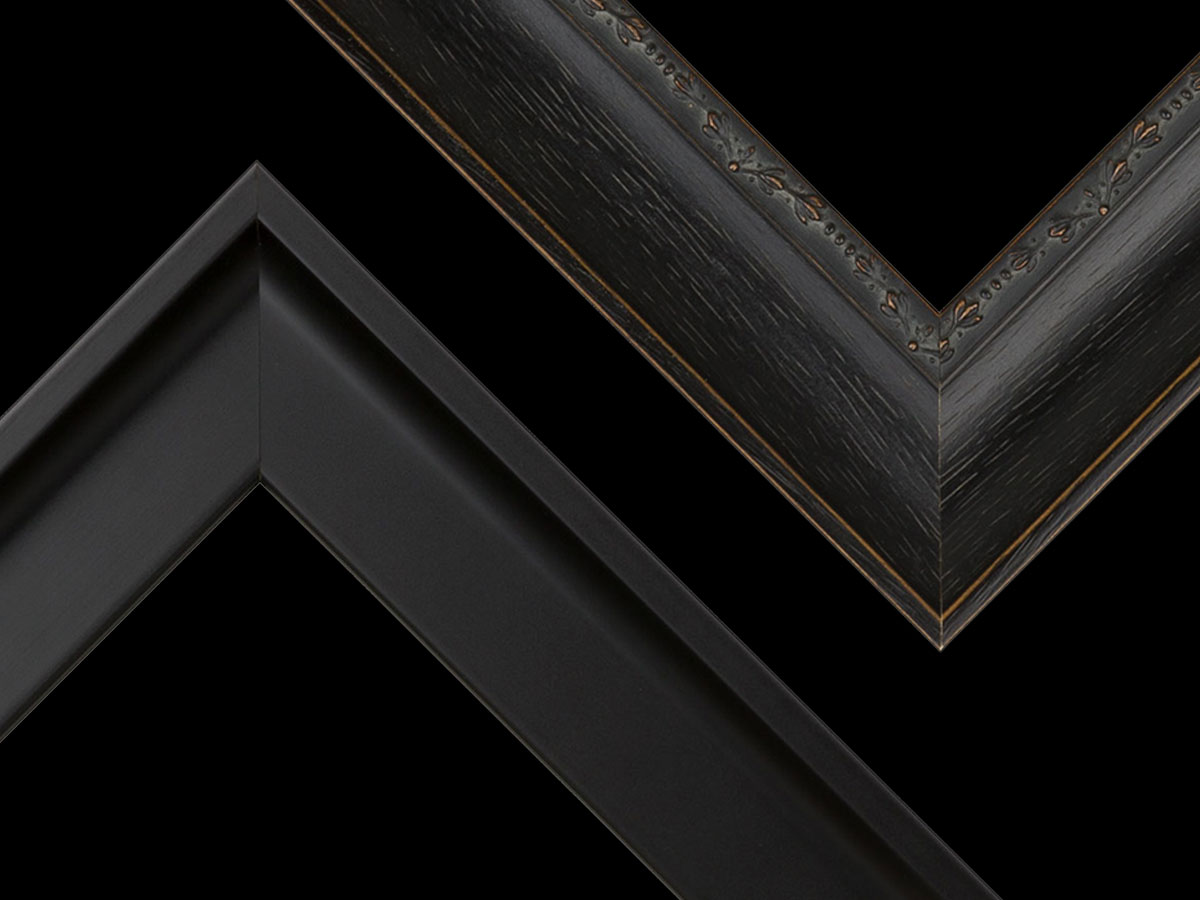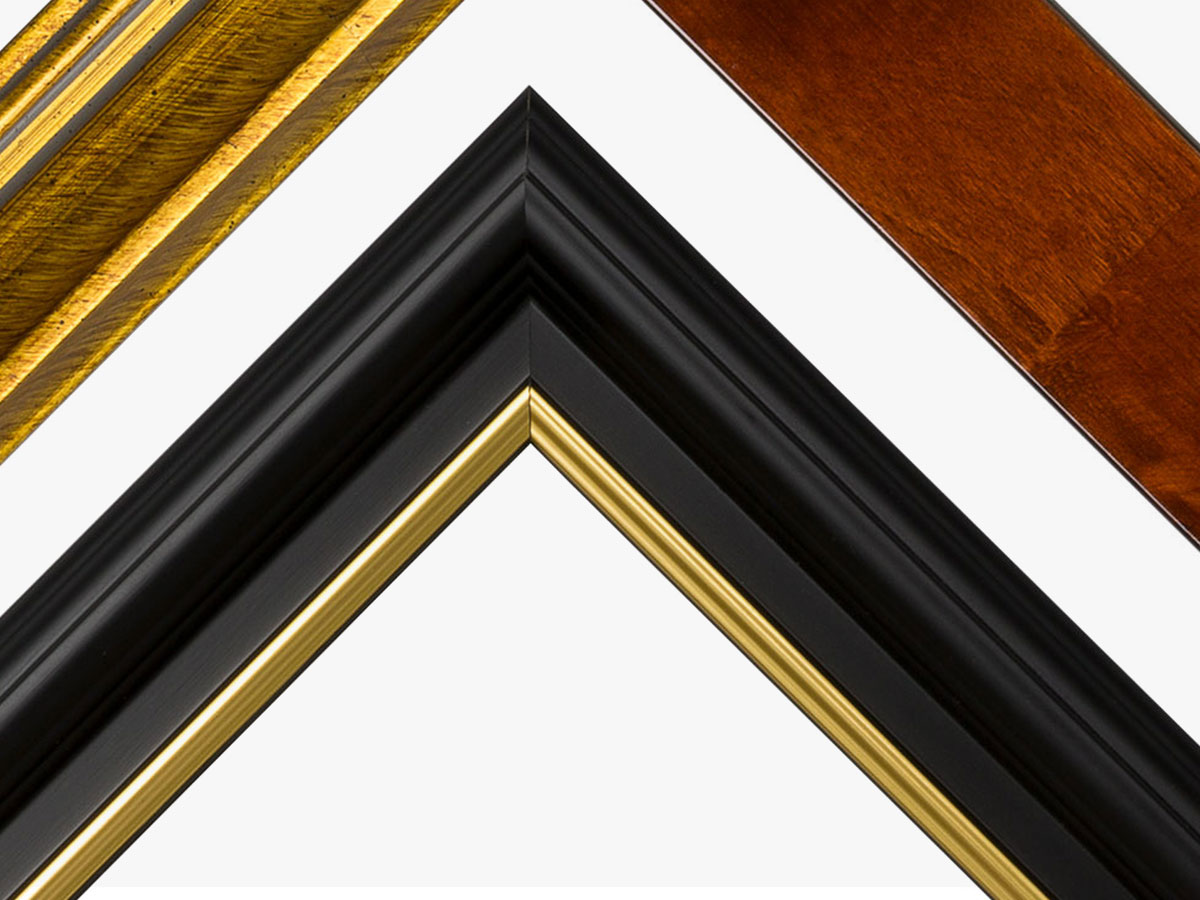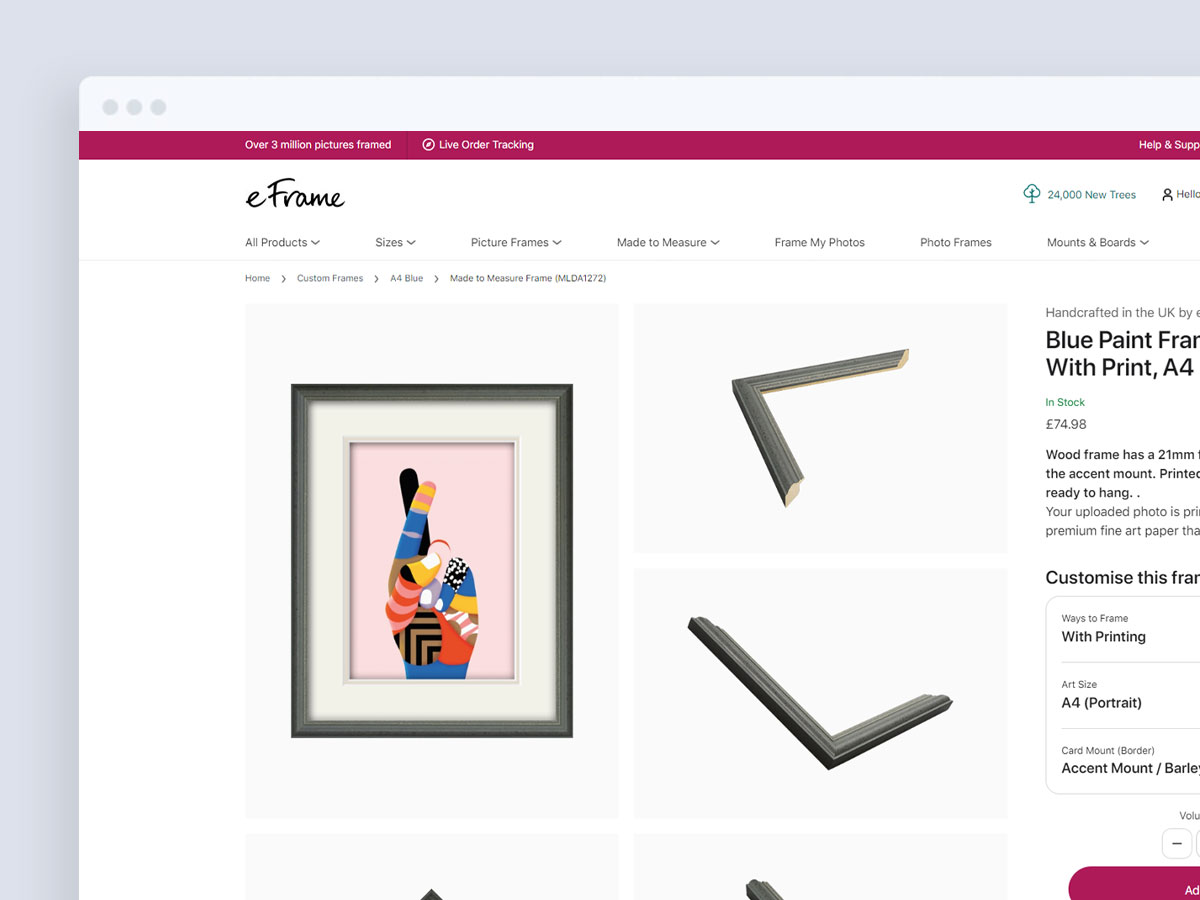Over 3 million pictures framed
The post 7 Trends We Love for Framing Art in 2023 appeared first on blog.
]]>Contents
- Sustainable and Eco-Friendly Materials
- Minimalist and Streamlined Designs
- Bold and Vibrant Colours
- Mixed Materials and Textures
- Creative Use of Mounts
- Play it Safe
- Frame Your NFT
- Bonus Tip: Go Big
- Conclusion
1. Sustainable and Eco-Friendly Materials
As the world becomes more environmentally conscious, it’s time for you to consider sustainable materials for your framing needs.
To ensure your frame is eco-friendly, research the materials used and opt for those with sustainable certifications. Choose from our range of FSC and PEFC mouldings to enhance your artwork while minimising your effect on the environment and forests. The benefits of choosing sustainable materials include reducing waste, conserving natural resources, and supporting ethical practices, like our tree planting initiative.
How do I know if my frame is eco-friendly?
To verify the sustainability of the materials used in a frame, look for our sustainable certification logos and eco-friendly labels like those below on product pages.


Other ways you can minimise your effect on the environment is to consider the following framing options:
- Reclaimed wood: Salvaged from old buildings, barns, and other structures, reclaimed wood offers a rustic and unique look.
- Bamboo: A fast-growing and renewable resource, bamboo is an eco-friendly alternative to traditional hardwoods.
- Recycled metal: Made from post-consumer materials, recycled metal frames provide a modern and industrial aesthetic.

Is choosing an eco-friendly frame more expensive?
Eco-friendly framing options can sometimes be more expensive than traditional ones, but the benefits of supporting ethical practices and reducing environmental impact often outweighs the extra cost. To find out how to offset the extra costs associated with going green, we have a money-saving top tip guide.
2. Minimalist and Streamlined Designs
Showcase your art without distraction by selecting sleek, modern frames with clean lines, simple profiles and designs. This is where metal frames shine. They tend to boast narrow profiles, which makes them discreet.
You can also use neutral colours, like black and white, as well as smooth and simple finishes to emphasise an understated look.
What else should I consider when framing minimal artwork?
Minimalist frame styles, like thin metal and wood frames, work particularly well with abstract art. Try creating a simple gallery wall, sticking to a consistent colour palette and frame style, using grid layouts and evenly spaced arrangements.
3. Bold and Vibrant Colours
Make a statement with eye-catching frames in bold and vibrant colours, like those in our hand-picked colourful and bright collection. Select the perfect hue to complement your artwork, whether a pop of colour or a daring monochromatic look. Mix and match colours for a truly unique and dynamic display.
To choose the right frame colour, consider the dominant hues in your artwork and select a complementary or matching colour. The most popular colours for 2023 include earthy tones, jewel shades, and muted pastels. You could also try:
- Contrasting colours: Choose frame colours that contrast with your artwork to create visual interest.
- Monochromatic: Select a frame colour that matches your artwork for a sleek and modern look.
- Colour blocking: Combine bold, contrasting colours to create a striking gallery wall.

4. Mixed Materials and Textures
Add depth and interest to your framed pieces by combining materials and textures. From metallic accents to wood grains, experiment with different picture frames to create a one-of-a-kind look that begs to be hung. Some of our favourite ideas include:
- Metallic accents: Pair metallic frames with soft white mounts for an eclectic, sophisticated look.
- Textured mounts: Use textured mounts to introduce interest and warmth to your framed artwork.
- Gloss frames: Combine beautiful glossy frames for added depth and visual interest.
To achieve a harmonious balance with mixed materials, select textures that complement each other and don’t overpower your artwork. Consider your art style when choosing materials and textures, ensuring they enhance rather than detract from the piece.
5. Creative Use of Mounts
While choosing the right frame for your artwork is essential, using mounts can add that extra touch of elegance and sophistication. You can make your frame look more luxurious and expensive by experimenting with extra-wide borders or incorporating multiple layers. Here are some ideas on how to use mounts creatively:
Extra-Wide Borders
Extra-wide borders can create a dramatic effect and draw attention to your artwork. They can also give your piece a gallery-like appearance, making it stand out in any room. To achieve this look:
- Customise your mount to include a wider border by selecting a “gallery mount” or by manually adjusting the borders in our mount design studio. Customised mounts with extra-wide borders will give your artwork breathing space and create a beautiful effect. Ensure borders are at least 80mm wide.
- Choose a colour that complements or contrasts with your artwork to accentuate the piece.
- Consider the overall dimensions of your framed piece, ensuring the extra-wide border doesn’t overpower your artwork. The bigger your picture and frame, the wider your mount borders should be.
Multiple Layers
Layering mounts is another creative way to add depth and a touch of sophistication to your framed artwork. You can achieve a luxurious look that enhances your art by using multiple mount layers. To create a multi-layered mount:
- Choose two or more mounts in complementary colours or varying shades of the same colour for a subtle effect.
- Experiment with different layers’ offsets to create visual interest.
- Consider the overall thickness of the layers and ensure that the bottom layer is always deeper than the layer above.
By using mounts creatively, you can elevate the appearance of your frame and give your artwork the attention it deserves. So go ahead, think outside the box (or inside the frame), and explore new ways to make your framed piece look more expensive and eye-catching.
6. Timeless Colours
While it’s fun to experiment with the latest trends, sometimes you can go right with the tried-and-true classics. When it comes to framing, colours like black, white, and oak will always be in style, thanks to their versatility and timeless appeal.
- Black frames: These sophisticated frames can suit any artwork and effortlessly blend with various interior design styles. They’re perfect for creating a bold statement and drawing attention to your art. We have a guide all about styling black frames.
- White frames: Clean and crisp white frames offer a fresh, modern look that can brighten up any space. They’re ideal for complementing colourful or minimalist artwork and creating a basic gallery wall.
- Oak frames: Offering warmth and natural beauty, oak frames bring an organic touch to your artwork. They work well with various styles, from traditional to contemporary, and can be easily integrated into most rooms.
No matter the current trends, you can always rely on these classic colours to provide a stylish and enduring frame for your treasured artwork.
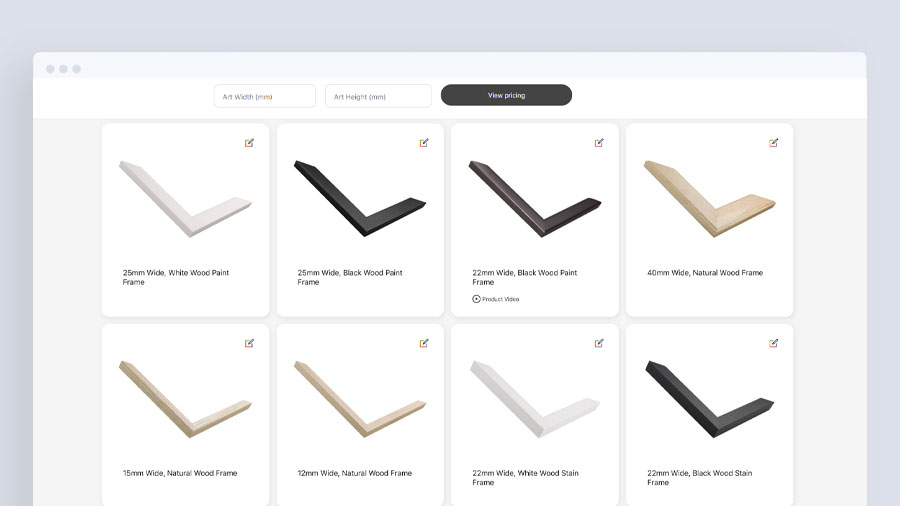
7. Framing NFTs: Bringing Digital Art into the Physical World
As NFTs (non-fungible tokens) gain popularity in art, many collectors and enthusiasts are seeking ways to display their digital art in physical form.
Before printing and framing an NFT, make sure you consider the following:
- High-quality printing: Choose a high-quality printing service that specialises in reproducing digital art. Opt for archival-quality paper and ink to ensure your NFT print remains vibrant and fade-resistant. Our print and frame service lets you upload and print digital images onto high-quality archival paper.
- Custom framing: Select a custom frame that complements your NFT print, considering factors such as colour, material, and style.
- Protective glazing: Preserve the quality of your NFT print by opting for protective glazings, such as our UV-resistant Clarity+ acrylic. UV-filtering glass will protect your print from fading and discolouration caused by sunlight.
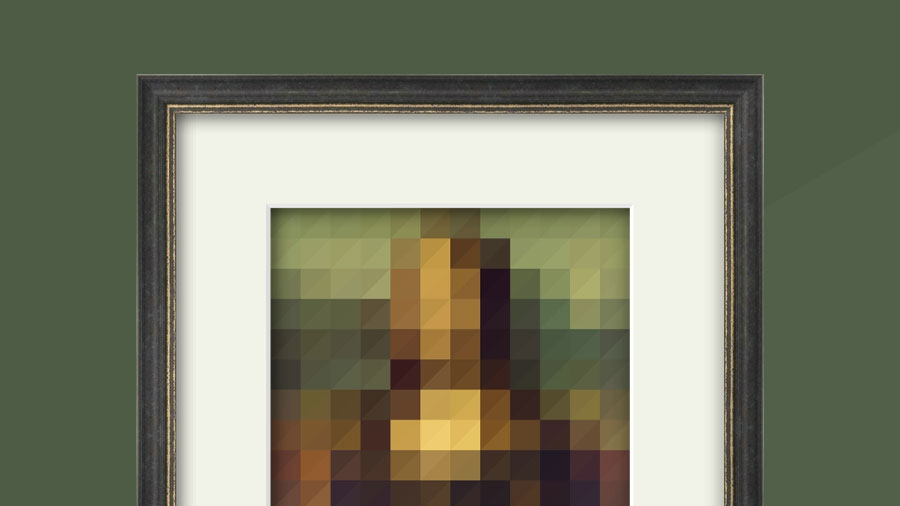
Bonus Tip: Oversize Statement Art
Another trend gaining traction in 2023 is the use of oversize statement art to create a focal point in your space. Large-scale pieces can make a bold impact and make your house look expensive. Here are some tips on how to incorporate big statement art into your home:
- Choose the right piece: Select artwork that resonates with you and reflects your style. Consider the piece’s colours, subject matter, and style to ensure it complements your existing decor.
- Consider the space: Ensure the artwork is proportionate to the wall or area where it will be displayed. Avoid overcrowding the space with too many other decorative elements, allowing your statement piece to take centre stage.
- Frame it well: Invest in a high-quality frame that enhances the artwork without overpowering it. Consider the frame style, material, and colour to ensure it complements the piece and interior design. Our guide all about framing oversize art can help.
- Placement is key: Hang your statement piece at eye level, ensuring it’s easily visible and can be appreciated from various vantage points within the room.
By embracing statement art, you can create a stunning visual focal point in your room and save money vs a gallery wall, transforming it into a stylish and high-end environment to live or work in.
Ready to Refresh Your Art?
Now that you’re equipped with the latest framing trends for 2023, it’s time to breathe new life into your artwork and transform your walls. Remember to consider sustainability, minimalism, bold colours, mixed materials, and unique mounts when selecting your frames. Whether you’re updating a single statement piece or creating an entirely new gallery wall, these trends will help you showcase your art in the most captivating and stylish way possible. Get started by trying our online framing service, which helps you frame the things you love, no matter the size or style.
The post 7 Trends We Love for Framing Art in 2023 appeared first on blog.
]]>The post Top 10 Tips for Styling Black Picture Frames appeared first on blog.
]]>- Black and white photography: The classic combination of black and white photography with black frames creates a stunning and sophisticated display. The monochromatic aesthetic lets the viewer focus on the image’s composition and subject matter. To further enhance the visual impact, choose a frame style and finish that complements the texture and style of your monochromatic piece. Get more style advice for framing monochrome art.
- Bold, colourful artwork: A black frame can provide a striking contrast against vibrant and bold artwork. By surrounding colourful pieces with a black frame, you can emphasise the colours within the artwork and create a visually engaging display.
- Minimalist or abstract pieces: Black frames can enhance the contemporary and modern feel of minimalist or abstract art. The simplicity of a black frame complements the clean lines and geometric shapes often found in these styles of art.
- Typography or graphic prints: The clean and defined edges of a black picture frame can work harmoniously with typography or graphic prints. The frame’s structure helps accentuate the visual impact of text or graphic elements.
- Vintage or historical artwork: Pairing vintage or historical pieces with an ornate black frame can create a sense of elegance and sophistication. The black frame can add depth and richness to the artwork, evoking a feeling of timelessness.
Because they’re so versatile, you can confidently display a wide range of artwork styles, but where do you start when designing and picking a suitable black frame?
Contents
- Choose the Right Frame Size
- Coordinate with Your Colour Scheme
- Experiment with Frame Styles and Materials
- Create a Gallery Wall
- Use them as a Focal Point
- Mix and Match with Other Frame Colours
- Incorporate Frames into Shelving Displays
- Use Frames in Unexpected Places
- Play with Frame Orientation
- Consider Frame Groupings
1. Choose the Right Frame Size
Selecting the perfect frame size is crucial for achieving a balanced look. To help you make the right choice, measure your artwork and wall space to determine the ideal frame size for your room. Black frames can make a bold statement in larger sizes, while smaller frames can add subtle accents. To get started with frame sizes, take a look at our picture frame size guide. You might be wondering whether you need a black custom frame or black picture frame – we have a guide for helping you choose between custom or standard sizes.
2. Coordinate with Your Colour Scheme
Black picture frames can complement or contrast with various colour schemes, creating a harmonious and stylish appearance. Identify the primary colours in your room and consider how black frames can enhance these shades. Black frames work particularly well with:
- Monochromatic colour schemes
- Bold, contrasting colours like red or yellow
- Neutral palettes, adding depth and elegance
In some cases, other frame colours might be more suitable, such as white frames for a light and airy atmosphere or gold frames for a more traditional and luxurious feel. Explore our range of frame colours to get started.
3. Experiment with Frame Styles and Materials
Black picture frames come in various styles, such as ornate, minimalist, and contemporary. Choose a frame style that complements your interior design and enhances the overall look of your space. Black frames can add sophistication to modern or industrial settings while working well in traditional or classic environments. Browse our selection of black frame styles and consider the following options:
- Ornate black frames for a traditional or luxurious look
- Minimalist black frames for a modern or Scandinavian style
- Contemporary black frames for an eclectic or industrial vibe
Should I choose a wood or metal frame?
Wood and metal black picture frames each offer their unique characteristics and can complement different interior styles and artwork types.
Wood frames often provide a more traditional, warm, and natural appearance, while metal frames look sleeker, more contemporary, and minimalist. Check out our wood vs metal frame buying guide for more help.
When should I opt for an ornate black frame versus a simple one?
Ornate black frames work well with traditional or luxurious interior styles, while simple black frames are better suited for modern or minimalist designs.
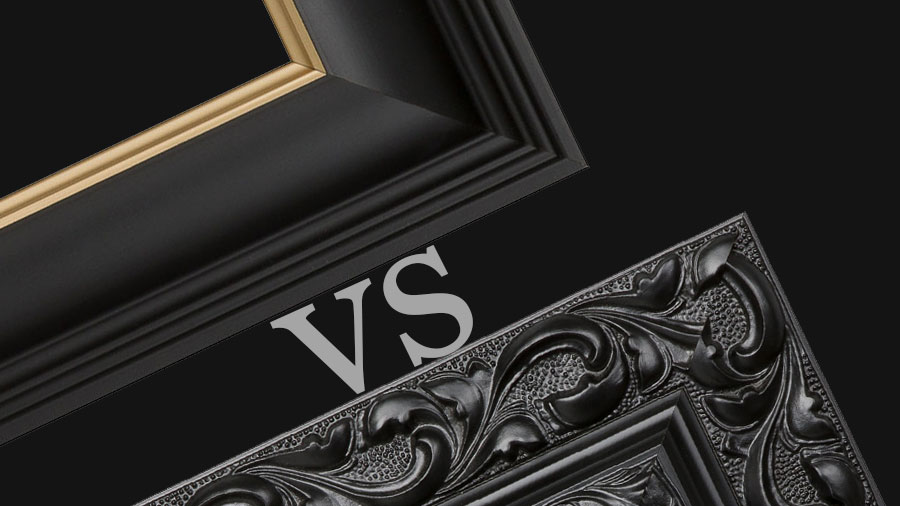
How do I decide between a matte or glossy black frame finish?
The choice between a matte or glossy finish depends on your artwork and the overall style of your interior. A matte finish can provide a subtle, understated look, while a glossy finish adds glamour and drama.
4. Create a Gallery Wall
A gallery wall featuring black picture frames can create a cohesive and visually striking display. Black frames can help unify diverse artworks and create a sense of harmony. Plan a gallery wall layout, incorporating black picture frames in different sizes and orientations. For tips on arranging a gallery wall, check out our guide to designing the perfect gallery wall or gallery wall inspiration.
5. Use them as a Focal Point
A large black picture frame can be a focal point in a room, drawing attention to your artwork and creating visual interest. Select a prominent location, ensuring the frame enhances the room’s overall appearance. Consider the positioning of your artwork to maximise its impact.
Expert Tip: Use a Mount to Draw Even More Attention
Black frames can be paired with a wide range of mounts. White or off-white mats are classic choices, while coloured mounts can add a pop of contrast. To maintain harmony, choose mounts colours that complement the artwork.
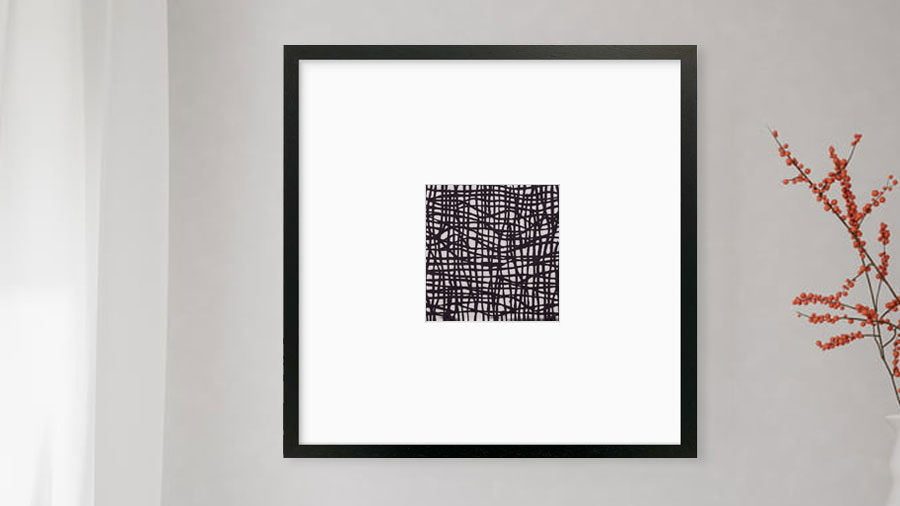
6. Mix and Match with Other Frame Colours
Combining black frames with other colours, such as gold, silver, or white, can create a visually appealing display. Black frames can ground a mixed arrangement or contrast lighter-coloured frames. Experiment with mixing black frames with other frame colours. Explore our fusion collection for products that pair well in a mix-and-match style display.
7. Incorporate Frames into Shelving Displays
Add black picture frames to your bookshelves or floating shelves for an eye-catching display. Black frames can add depth and contrast to your shelving arrangements, creating a visually interesting and dynamic display. Arrange black picture frames on your shelves, taking care to maintain balance and visual harmony with other objects. Remember to coordinate your frames with other decorative items.
8. Use Frames in Unexpected Places
Get creative by placing black picture frames in unconventional locations like kitchens, bathrooms, or hallways. In these spaces, black frames can add a touch of sophistication and visual interest. Identify unusual locations where framed art could create a surprising and stylish addition to your home. Make sure to choose appropriate artwork for these spaces, considering factors like:
- Room function (formal vs relaxed)
- Who uses the room (children vs adults)
- Available wall space
For more help hanging your frames, check out our hanging guide.
9. Play with Frame Orientation
Alternate between portrait and landscape orientations. Black frames can add structure and balance to your layout, regardless of the orientation. Plan your frame arrangement, experimenting with different orientations before hanging.
How can I create visual interest with black picture frames in a minimalist interior design?
To create visual interest in a minimalist setting, experiment with different frame styles, such as slim, bold, or textured black frames.
10. Consider Frame Groupings
Group black picture frames together for a bold, cohesive look. Black frames can create a dramatic and eye-catching effect when arranged in groups.
Mixing various black frame styles in a single arrangement can create an eclectic and visually engaging display. Consider using a unifying theme, a consistent colour palette, or similar frame proportions to achieve a well-planned look.
Bonus Tip: Frame a Canvas
Don’t be afraid to mix black canvas frames with traditional black wood or metal picture frames. By incorporating one of our canvas floater frames, you can add variety to a gallery wall or create a singular focal point in your room. This unique framing option brings a new dimension to artwork presentation, combining the sophistication of black frames with the textured depth of canvas. It’s ideal for a range of artistic styles, from abstract paintings to monochrome photographs, black canvas frames serve as a versatile second choice when framing your artwork and photography.
Expert Opinion: Highlighting Artwork
The primary purpose of any frame is to showcase your artwork, but canvas frames are particularly effective at drawing attention to the details within the art. Because canvas art doesn’t sit behind glass, your picture has a more authentic and textured appearance. You’ll also want to choose artwork that benefits from the contrasing shadow gap, such as bright, colourful pieces or striking black and white photographs.

Conclusion
Use the tips to get started and create the perfect frame with our online frame designer. With our guidance and your personal touch, you can create a look that showcases your art in a stylish, timeless frame. If you want more help and styling advice for choosing a picture frame in general, check out our piece on choosing a frame.
The post Top 10 Tips for Styling Black Picture Frames appeared first on blog.
]]>The post Custom vs Ready Made: Which to Choose? appeared first on blog.
]]>Custom frames are frames that are tailored to fit a specific piece of artwork or photograph in terms of size and style. They are made to measure and designed to complement the item being framed. Because they’re made to a bespoke size, they can better protect your piece and increase its perceived value. Custom frames are typically made with high-quality materials and can be customised to meet your preferences, including budget and appearance.
Off-the-shelf picture frames, also known as ready-made frames, are pre-made frames that come in standard sizes and basic styles. These picture frames are mass-produced and can be found online in high-street shops. While they may be convenient and budget-friendly, they often look bland and lack the high-quality materials used in custom frames. Critically, however, they may not fit your artwork perfectly, which could compromise your item’s overall appearance and protection.
We allow you to choose the exact dimensions, materials, colours, and styles that suit your taste and complement your item.
Where can I buy frames?
Online custom framers, like eFrame, offer both custom and standard size frames. We allow you to choose the exact dimensions, materials, colours, and styles that suit your taste and complement your item. Custom frames, often called made-to-measure or bespoke frames, can also be found in traditional framing shops, although they are typically more expensive than buying from an online framer. Learn more about the benefits of online framing.
You don’t need to have your artwork or photograph printed before finding a frame. We allow you to print and personalise your frame together. This allows you to upload your digital image and print it to the desired size and quality before framing. However, if you have a physical print or artwork, all you need to do is measure it and tell us the dimensions – you can fit your picture at home yourself.
Is custom framing worth it?
With the key differences between custom and ready-made frames covered, let’s discuss why custom frames might be a better choice for you.
Personalisation and choice
When it comes to custom framing, one of the main benefits is the ability to personalise almost every aspect of the frame. Unlike off-the-shelf frames, where what you see is what you get, custom frames can be tailored to your heart’s content.
Here are some of the key elements of a frame that you can customise using an online framing tool like our design studio.
Frame material: With custom framing, you can choose from a range of materials, including wood, metal, and eco-friendly options that have PEFC and FSC certifications. We stock over 600 frame options in wood and metal.
Frame colour and finish: Custom frames come in a range of colours and finishes, from classic wood tones to bold metallics. The wide choice on offer means you can choose a frame that complements your artwork perfectly. Try matching the colour scheme of your artwork or photo, or select a contrasting colour to make it stand out. This choice allows you to create a cohesive design that complements your existing interior style, whether contemporary, traditional, or anything in between. Don’t hesitate to email us for expert advice or use online inspiration if you need a bit of creative help.
Mount colour, texture, and thickness: A mount is a decorative card border between the artwork and the frame, and it can have a big impact on the overall look of the piece. With custom framing, you can choose from a wide range of mountboards to complement your artwork. Try mixing and matching different mouldings with mount colours to understand what options are available and which would work best for your artwork and decor.
Consider choosing an accent mount that complements your artwork or photo by matching the colour of the mount with a prominent colour in the piece. This can help draw attention to the artwork or photo and create a cohesive look.
Glazing type: Custom frames offer a range of glazing options, including glass or acrylic, with different levels of UV protection and anti-reflective coatings. This helps protect your artwork or photo from damage and fading and allows you to showcase it in the best possible light.
With so many customisable options available, creating a frame unique to you and your piece is only possible by opting for custom vs ready-made.
The perfect fit
Another key benefit of custom framing vs choosing an off-the-shelf option is the ability to order a frame that fits your pictures’ dimensions to the millimetre. Our custom frames are individually crafted in the UK by our professional framers to match your item’s precise dimensions. By making a frame that fits perfectly, your picture can be fitted securely and will look better when hung on the wall. We have a handy guide on hanging your frames.

A well-fitted frame significantly improves the visual appeal of your artwork, accentuating its details and allowing it to take centre stage. In contrast, a poorly fitted frame can detract from its beauty and make it appear inexpensive. We have a measuring guide to teach you how to measure your picture to maximise visual appeal.
The flexibility ordering bespoke sizes provides ensures that even uniquely sized pieces can be displayed beautifully without compromising their integrity (cropping them to fit the frame).
A frame that fits your picture perfectly prevents any slipping or movement within the frame, which can cause creases or tears, ensuring the piece remains in its original condition. If your frame has a mount, use acid-free hinging tape to keep your artwork in place to prevent slipping.
Finally, you can order custom frames for non-flat items such as 3D objects or textiles. This is known as shadowboxing or object framing. Shadowboxing involves creating a space between the item and the glazing using a spacer, allowing the item to be displayed three-dimensionally. Object framing involves creating a custom frame that accommodates the depth of the item. If you have a non-flat item that you want to custom frame, it is best to choose a frame from our deep frame range and contact us to get a quote.
Quality materials that last
A frame manufactured using quality materials ensures your picture is properly protected and preserved from the damaging effects of ultraviolet light, moisture, accidental damage and insects. Custom frames offer a wide range of premium materials, including solid wood and aluminium, that provide superior durability and resistance to wear and tear compared to cheaper, off-the-shelf alternatives. Consider preservation framing for valuable or sentimental artwork.
Solid wood frames offer timeless elegance and natural warmth that can complement any artwork or photo. These frames come in various wood types, such as oak, pine, and walnut, and can be stained or painted in a range of colours to fit your style and décor, like black, white and gold.
On the other hand, aluminium frames offer a sleek and modern look that can complement contemporary artwork. These frames are lightweight and durable, making them an ideal choice for large or heavy pieces. They come in a variety of colours and finishes, too, including brushed, matte, and glossy.
In terms of glazing, UV-protective and anti-reflective glass or acrylic can be chosen. These premium glazing options help prevent fading and damage caused by sunlight while maintaining your artwork’s vibrancy and condition over time. You can learn more about our available glazing options here.
Finally, there’s a range of acid-free and archival-quality mounts and backing board materials. These are specifically designed to safeguard your artwork from discolouration, deterioration, or damage caused by the damaging chemicals found in standard mounting and backing materials like MDF. We have a range of conservation grade mounts as well as barrier board to keep your piece protected for years.
At eFrame, we offer a wide range of premium materials for custom framing, ensuring that your artwork or special items are properly protected and showcased. Contact our team of expert framers to discuss the best materials and options for your unique piece, and be confident that our frames will stand the test of time.
Protect your investment
Beyond materials, custom framers can employ conservation and preservation techniques to combat damage from insects, moisture, and other environmental hazards. If you send your artwork to us for framing, we use museum-quality techniques, adhering to the highest archival standards, ensuring your artwork remains protected for future generations.
Investing in custom framing services safeguards your artwork and boosts its value over time. A well-framed artwork can significantly appreciate in value, making it a wise and alluring investment for the future.
By harnessing high-quality materials and conservation and preservation techniques, custom framing guarantees protection against the elements, ensuring the beauty and value of your artwork endure for years to come.
The eco-friendly option
Generally speaking, there are more eco-friendly frames with PEFC and FSC certifications available when ordering a bespoke frame vs a ready-made frame.
Off-the-shelf frames often use low-quality materials and are made with little thought into their damaging effects on the environment. In contrast, custom framing utilises high-quality, sustainable materials with a reduced environmental impact. Additionally, custom framing allows you to repurpose old frames and materials, reducing waste and minimising your carbon footprint.
We take a responsible and sustainable approach to framing and strive to reduce waste, use sustainable materials, and minimise our carbon footprint.
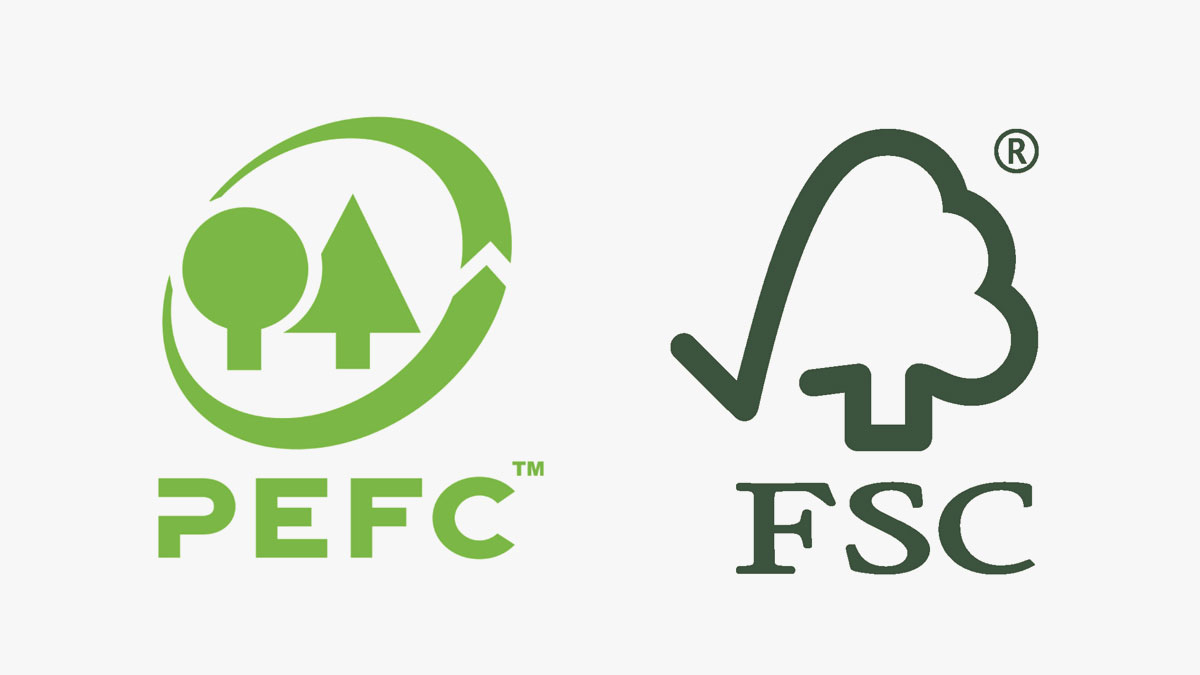
Alternatives to custom framing: When to buy off-the-shelf
While custom framing is an excellent option for preserving and showcasing your artwork or photographs, it may not be the best choice in certain situations.
Small budget
If you’re working with a tight budget, there may be better options than custom framing. While custom frames offer numerous benefits, they can be more expensive than off-the-shelf alternatives due to their personalised nature and premium materials. If cost is a concern, consider ready-made frames or alternative display options such as photo albums or digital displays.
We have a guide all about why framing can be expensive. Still, if you have your heart set on a custom frame, we also have some top money-saving tips as well as a range of cheap picture frames to suit all budgets.
You’re framing a low-value or replaceable piece
If you have a temporary or low-value picture that you don’t plan to keep for long, investing in custom framing may not be necessary. Off-the-shelf frames can provide adequate protection and visual appeal for these items. Additionally, if you plan to rotate your artwork or photos frequently, investing in custom framing for each piece may not be practical.
You can make your own
If you have the DIY skills and equipment to create a frame, why not try making one yourself? DIY framing can be a cost-effective and fun way to display your artwork or photos, allowing you to customise every aspect of the design.
Remember, each situation is unique, and there may be exceptions to these guidelines. If you need help determining whether custom framing is the right option for your piece, talk to one of our professionals for personalised advice.
Summing up
While custom framing offers many benefits for displaying and preserving your pictures, ready-made frames can be a practical option in certain situations. Custom framing provides precise sizing, personalisation options, more choice, high-quality materials, and superior protection, making it an ideal choice for valuable or sentimental pieces. However, if you’re on a tight budget or framing a low-value or replaceable item, a ready-made frame may provide adequate protection and visual appeal. Ultimately, deciding between custom and ready-made framing depends on your needs and preferences. Armed with the above, you can now ask yourself the following questions to determine whether a custom or ready-made frame is best for you.
- What is the value of the piece being framed? If it’s expensive, go custom.
- What is the size and shape of the piece? You can choose a made-to-measure or ready-made frame if it’s a standard size.
- How important is the protection and preservation of the piece? If you have a throwaway piece, choose ready-made.
- Do I want to personalise the frame’s style? If you want to create a one-of-a-kind look, choose a custom frame.
- Do I want to match the frame to my existing decor? Custom frames offer a wider range of options, making it easier to copy an existing look.
- What is my budget? Custom frames are normally more expensive, but because we manufacture everything in the UK, there’s no price premium for custom frames with eFrame.
- Am I willing to pay more for high-quality materials and craftsmanship? Choose custom. Off-the-shelf frames are often made to a lower standard.
The post Custom vs Ready Made: Which to Choose? appeared first on blog.
]]>The post Why should I choose online framing? appeared first on blog.
]]>Have you ever had a piece of art or photo you never got around to framing? The hassle of finding a reputable local framer or the high cost of bespoke framing can often be a deterrent.
But framing your artwork or photos can be easy and inexpensive. With online framing, you can frame your favourite pieces affordably and conveniently – from the comfort of your home.
If you want to transform your walls with your favourite art and photos, it’s time to explore the world of online framing. With over 22 years of experience, we’re the UK’s leading online picture framer, and we’re dedicated to helping you find the ideal frame to display your cherished memories and artwork.
With our expert guidance and a vast selection of framing options, you can create a picture frame you love for your artwork or photos quickly.
Why should you use an online framer?
When framing your artwork or photos, using an online framer (like eFrame) offers a range of benefits you won’t find in high street shops.
Explore a huge choice of moulding styles
Whether you’re looking for a traditional wooden frame or a modern aluminium frame, an online framer can offer a wider selection than a physical store due to the lack of space limitations. This includes not only a wide range of styles and colours but also different materials such as wood and aluminium. Thanks to our easy-to-navigate website, you can filter over 600 mouldings styles in seconds.
Our online selection doesn’t stop at picture frames, in fact, you can order floater frames to suit canvases too. Just like our picture frames, you can order these float frames in a range of styles to suit your artwork.
Many online framers offer both custom and ready-made sizes, allowing you to find the perfect fit for your artwork or photo. Custom sizing gives you the freedom to choose a frame that perfectly fits the dimensions of your piece, while ready-made sizes are a quick and convenient option for standard sized artwork or photos. If you don’t know where to begin with sizing, check out our size guide which helps you find a frame in the right dimensions for your art.
Competitive pricing
As an online framer, we don’t have the same overhead costs as physical stores, so we can offer more affordable prices without sacrificing quality. Plus, we provide transparent pricing with no hidden fees, so you know exactly what you’re paying for – we also make it easy to compare prices against other framing companies.
Convenience
Our website allows you to order your frame from the comfort of your own home, saving you time and hassle. Our virtual framing tool lets you preview your artwork or photos in different frames and styles. Go a step further and opt to print and frame your digital photo with us; we professionally fit it, saving you the time and effort of doing it yourself.
Delivery options
Our online framing service is ideal for customers who live in remote or rural areas or for those who have mobility issues. With our website, you can order your frame from anywhere in the country and have it delivered straight to your door. Our specially designed packaging ensures your framed artwork or photos arrive safely and securely.
Virtual frame tools and customisation
Many online framers, us included, provide virtual framing tools that allow you to upload an image of your artwork or photo and see how it would look in different frames and mount options. This can help you decide which frame style works best for your piece. The same tools allow you to create a unique and personalised frame (or mount) that suits your needs. Experiment with custom borders, glazing options and more. Big-brand high-street shops offer little to no customisable options, which might mean your frame doesn’t fit your picture properly.
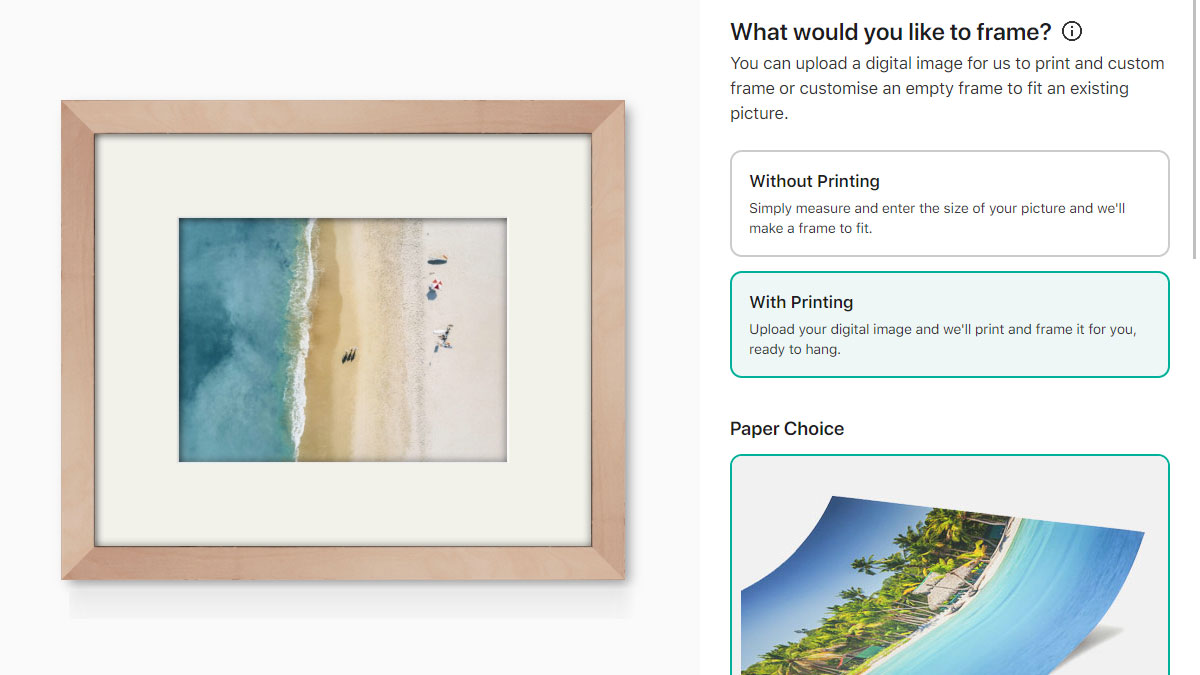
Inspiration and ideas
Online framers often provide inspiration and ideas for framing through their website, blog, and social media channels. This can spark your creativity can help you explore different framing styles and materials you may not have considered otherwise.
Quality
While big department store frames are certainly affordable, the frames are often made abroad in Asia, and the quality is often reflected in the price you pay. On the other hand, online framers often use premium materials and employ experienced craftsmen to ensure that your artwork or photos are framed to the highest standard – in the UK.
Customer support and expert advice
Online framers often offer multiple customer support options, such as email, phone, or chat, which can provide quick and convenient help. eFrame also offers a huge range of framing how-to guides to help you frame at home. In addition, online framers often employ framing professionals who can offer expert advice and recommendations on framing styles and materials. This expertise can also be found online in our buying guides to assist you in ensuring your piece is properly preserved and presented.
Ordering ease
Online framing offers a straightforward ordering process. You can easily upload your photo or artwork to the online framer’s website, select your framing options, and place your order from the comfort of your home.
Contract framing and fulfilment
Online framers can provide contract and commercial framing services for businesses. Online framers possess a unique combination of expertise in framing, printing, technology, and logistics – at scale. This makes them well-equipped to provide additional services for businesses that high-street shops cannot. These services include contract framing for businesses with high volume needs and drop-shipping services for artists that want a simple, outsourced framing solution. With their expertise, online framers can efficiently and effectively produce high-quality frames and deliver them anywhere, quickly.
Get your frames fast
One of the key benefits of using an online framer is the speed and efficiency of the process. Online framers often offer a faster turnaround time than traditional brick-and-mortar framers. This is because online framers usually have a streamlined process, which means less time is spent on manual tasks like cutting and measuring. Additionally, online framers often have a larger team of experts working to fulfil orders, which means they can handle more orders simultaneously.
Fast turnaround times can be beneficial if you need a framing job completed quickly, such as for a last-minute gift or an urgent exhibition. Some online framers even offer express delivery options for an additional fee, which means you can have your framed artwork or photo in your hands in as little as 24 hours. Just select priority service when you checkout with us.
Are there any drawbacks to online framing?
We understand that some customers may have concerns about using an online framer, especially if they’re used to using a high street shop.
One common concern is the quality of the product. Some customers may be worried that the quality of the framed artwork or photos they receive from an online framer won’t meet their expectations. However, over 600,000 customers, including professional artists and photographers, testify to the quality of our products. We use the same high-quality materials as local framers to ensure that your framed artwork or photos look their best and last a lifetime.
Another concern is shipping and handling. Damage in transit can be an issue; however, we use specially designed-packaging and work with reputable shipping companies to ensure your product arrives in pristine condition. If it doesn’t, we ship a replacement frame out on the same day.

You might think the range of customisable options is less varied online than in your local framer. However, our virtual framing software allows you to customise each frame to your heart’s content, allowing you to create the perfect frame in minutes.
Finally, some argue that being unable to physically touch and feel the moulding before purchasing is a problem. However, we offer free-of-charge samples, which allow you to see the materials and the quality of the frame in person, giving you peace of mind before you buy.
At eFrame, we’re dedicated to providing a high-quality service that addresses all common concerns. If you’re still not sure, get in touch and talk to one of our expert framers.
How to choose the best online framer
Choosing the right online framer can make a huge difference in the appearance of your frame once it’s been hung.
Firstly, quality is a crucial factor. Look for an online framer that guarantees the quality of their products and uses high-quality materials to ensure that your frame lasts. Read reviews or testimonials from other customers to help you determine if the company has a good reputation, like our Trustpilot score.
Secondly, consider customisation options. Choose an online framer that offers a range of bespoke framing options, such as different frame styles, materials, and sizes. It’s important to select an online framer with virtual framing tools, allowing you to preview your artwork or photos in different frames and styles to create the perfect frame that meets your specific needs.
Price is also an essential factor to consider. Look for an online framer that offers competitive pricing without sacrificing quality. Ensure they provide transparent pricing with no hidden fees, so you know what you’re paying for. Check out our money-saving guide for tips.
In addition to the above factors, consider the usability of the online framer’s website. Look for a website that is easy to navigate and provides clear information about their framing services. A well-designed website can make the framing process easier and more enjoyable.
Firstly, a brilliant website. Nobel prize to its designer. Then the company does what it says on the tin – what was agreed.
– Customer Trustpilot Review
Another factor to consider is product photography. Choose an online framer that provides clear, high-quality photographs of their frames and products. This can help you better visualise what your framed artwork or photos will look like and make it easier to choose the perfect frame. We spent over six months photographing our frames, taking 4,500 images in the process.
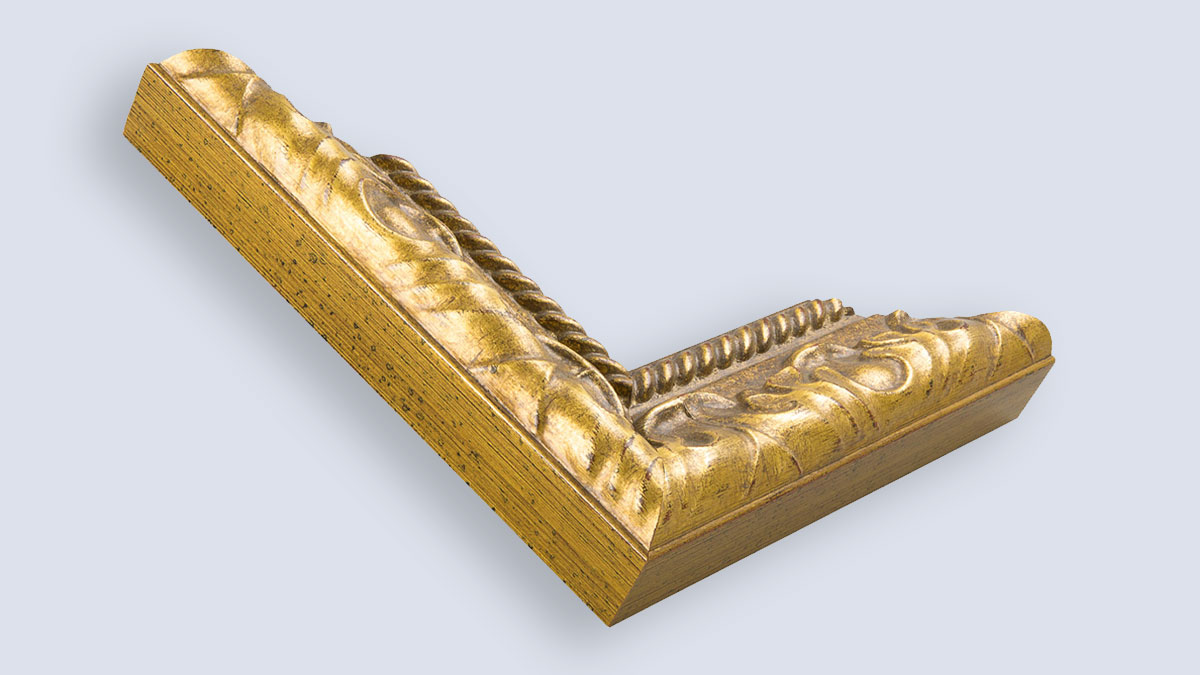
It’s important to select a framer that offers premium shipping options to ensure your frames arrive safely. If you’re local, we allow you to collect your frame too!
By considering the above, you can choose the best online framer for your needs and enjoy high-quality, customised framing for your artwork or photos.
Framing has never been easier
In today’s digital age, choosing an online framer is a convenient and cost-effective way to enhance your artwork’s or photos’ beauty. Considering the abovementioned factors, you can choose the best online framer for your needs.
At eFrame, we’re dedicated to providing high-quality, customised framing services that enhance the beauty of your artwork or photos. We offer a range of customisation options and a user-friendly website that makes the framing process easy and enjoyable. Our transparent pricing and reliable shipping options ensure that your frames arrive pristine.
Find a frame today
With over 3 million frames made, we’ve perfected the art of online framing.
ExploreThe post Why should I choose online framing? appeared first on blog.
]]>The post Commercial & Contract Picture Framing: An Expert Guide appeared first on blog.
]]>We’ve supplied thousands of quotes to professionals for framing artwork, ranging from simple requests for basic A4 frames to highly detailed quotes where we need to consider international deliveries and artwork installations for corporate clients.
Ordering many unique frames for large projects can be complex, so choosing the right framer and understanding the process is important. Whether you’re a seasoned art consultant or a business looking to start selling framed posters, this guide will help you to get complex or wholesale framing projects off to the right start.
Find the best framer for your project
As somebody looking for reputable contract picture framers in your area or online, it’s essential to consider various factors such as their experience, portfolio, customer reviews and capabilities.
You’ll want to start by creating a shortlist of potential framers.
First, research and gather information on framers with experience handling projects of the type you have. You can use search engines, review sites, and word-of-mouth recommendations to identify potential candidates. Collect contact information and make a note of any relevant details, such as their location (if you want to visit) and availability.
Next, review each framer’s portfolio to understand their capabilities and working practices. Again, focus on those who specialise in your required type of framing, and compile a list of potential candidates.
Ensure potential framers have the qualifications and certifications to handle commercial and contract framing projects. For example, eFrame is a member of the Fine Art Trade Guild. This ensures we have the necessary training and expertise to handle your project. A reputable framer, will typically display a portfolio of their past work on their website, allowing you to assess the quality and variety of their work to ensure they possess the necessary skills and experience for your project.
The framer you choose should be responsive to your inquiries and able to communicate clearly throughout the framing process. Consider sending an email or making a phone call to gauge their level of responsiveness using their contact page.
Finally, schedule a consultation with each framer on your shortlist. This is an opportunity to ask questions, review samples of their work, and get a sense of their professionalism and expertise.

Top questions to ask when looking for the best framer
Along with the above, the best way to find a trustworthy contract framer is to ask questions.
- What is your experience with commercial framing projects?
- Do you have the production capacity to manufacture the volume of frames I require?
- Can you provide references from previous commercial clients?
- What materials and techniques do you use?
- Do you offer delivery or installation services for commercial projects?
- What is your policy on returns and defects?
- Do you offer guarantees on your work or materials?
- How do you ensure the safety and security of valuable or delicate items during the framing process?
- Can you provide itemised quotes that break down the costs of materials, labour, and additional services?
- Can you provide a clear timeline for the project and milestones for reviewing progress?
- How do you handle unexpected issues or challenges that may arise during the framing process?
- Do you offer any additional services or resources that I find useful?
Asking these questions can help you identify a reliable framing partner who can meet your needs and provide high-quality work.
Make sure you check out the framers website for information about their commercial and contract services and case studies.
Request quotes
When preparing to contact your shortlist of framers, it’s important to provide a clear and comprehensive project brief.
What does the framer need to provide a quote?
- How many pieces need to be framed? Count the number of pieces you need framed and provide an estimate to the framer.
- What are the dimensions of the pieces? Measure each piece’s height, width, and depth (if applicable) and provide this information to the framer. If you need the frames making to an external size rather than internal size, make this clear.
- What artwork or objects are being framed? Identify the type of artwork or objects you need to be framed, such as paintings, prints, photographs, or certificates, and let the framer know.
- What is the desired frame style? Determine the style of frame you want, such as ornate gold frames, sleek modern frames, or wooden frames with a rustic finish.
- What glass or acrylic glazing type do you prefer? Decide on the type of glazing you want for your frames, such as non-reflective glass, UV-protective acrylic, or museum-quality glass. We have a handy acrylic vs glass guide to help you choose.
- Do you prefer any special materials or finishes? Determine if you have any special material or finish preferences, such as matte black frames, hand-painted frames, or distressed wood frames.
- What is the project timeline? Decide when you need the project to be completed and communicate this to the framer, so they can assess their availability and ensure they can meet your deadline.
- What is the budget for the project? Determine your budget for the project and communicate this to the framer, so they can provide a quote that fits within your budget. They might tell you up front that the budget is unrealistic given the requirements and offer advice to bring the cost down. There are lots of things that affect the cost – we have a guide all about how frame prices are calculated.
- How do you want the frames packed? Discuss the packaging and delivery of the finished framed artwork or object to ensure that it arrives safely and in good condition.
- Are there any special requirements or considerations? Identify any special requirements or considerations for your project, such as international shipping and delivery, installation services needed, or conservation framing techniques required for valuable items, and communicate this to the framer. This will ensure that the framer’s quote covers all aspects of the project, reducing the chance of surprising costs later .

What else to include
Besides providing the framer with a clear project brief and scope of work, here are some additional suggestions to help make the framing process easier and more successful.
If possible, provide high-resolution images of the item to be framed and any visual references for the desired frame style. This will help the framer better understand the project and offer a more accurate quote.
When requesting quotes from framers, ask for an itemised quote that breaks down the costs of materials, labour, and additional services. This will allow you to compare quotes more easily and understand the value offered by each framer.
Finally, inquire about guarantees and aftercare. Find out if the framer offers any guarantees on their work or materials, as well as their policies concerning returns and defects. This information will help you choose a framer who can provide the level of service and quality you require.
Evaluating the quotes
After receiving the quote, you should review it thoroughly to ensure you understand all the details. Pay special attention to whether the sizes are correct. If you have any questions, don’t hesitate to get in touch with the framer for clarification. Remember, although the cost is an important factor, also take into consideration the materials, turnaround time, and any additional requirements specific to your project when making your decision.
Once you’re happy with the price and confident of the framer’s reputation, request samples of the materials used in the project, such as frame mouldings, mount board, and glazing. This will allow you to assess the quality and ensure the materials complement your artwork or object. We offer free-of-charge samples for all project and commercial clients, including fully completed frame samples.
You should take the opportunity to discuss the project together one more time in greater detail to ensure you both have a clear understanding of the requirements and expectations. This should include discussing specific techniques or conservation methods for delicate or valuable items.
The quote usually includes a timeline and schedule, but before ordering, it’s always worth checking that their estimates are still accurate. This will help to ensure the project runs smoothly and is completed on time.
Top tips for managing your commercial framing projects with your framer
Once the order is in production, it’s important to maintain regular communication with the framer to ensure the project stays on track and meets your expectations. This can be done through phone calls, emails, or in-person visits.
Early on, you should try to establish a point of contact to liaise with. By maintaining contact with a particular individual within the framing company, it’s easier to ensure everyone is on the same page regarding project goals, timelines, and expectations. This also allows you to address any unexpected issues or challenges that may arise during the project, such as delays in materials delivery or changes to the artwork specifications.
We offer an account managed bespoke and high-volume contract framing service.
Check in regularly with the framer to see how the project is progressing. This will help you identify any issues or challenges early on. Promptly address any concerns or issues to prevent delays or problems.
Provide feedback to the framer throughout the project to ensure that the framing meets your expectations. This can include feedback on the materials used, the framing style, and the accuracy of measurements.
Establish a timeline for the project that includes milestones for reviewing progress and a completion date. This will help you and the framer stay on track and ensure the project is completed on time.
Conduct a final inspection of the framed artwork or object before delivery or installation.
By maintaining regular communication and addressing any issues promptly, you can effectively manage the project with the framer and ensure that the final product meets your expectations.
Finally, after everything has been completed, consider providing a testimonial or feedback to the framer. This can help build a positive and lasting relationship with the framer, which is vital to ensuring the successful completion of complex commercial projects.
Find a contract framer
For 25 years we have a provided businesses with world-class framing products and services. Our capability and flexibility allow us to tackle even the most demanding framing projects with ease.
ExploreThe post Commercial & Contract Picture Framing: An Expert Guide appeared first on blog.
]]>The post How to Sell Framed Art Online appeared first on blog.
]]>Are you a creator or curator?
When setting out to start selling art online, you first have to choose between the two ways to get into the business. Either create your own artwork to sell or find works by artists who need representation and somewhere for their products to be sold.
Sell your own art
Selling your own art means you will need to be the artist and the business director at the same time. This method means you have low costs, as there is no middleman, however relies on you having a presence that will bring customers to you with little effort. There are plenty of tools that take the pressure off some of the more technical stuff, so you won’t need to worry about being an expert in everything. Approaching galleries can provide exposure and may give you access to promotions or professionals that may help your business.
Curating other peoples works
The beauty of curating other peoples works is that anyone can do it, you don’t need to be highly skilled in artistic crafts, but it is important to have an interest. Selling works by other artists can involve selling original works, selling prints or licensing artwork for merchandise. This role is much more business-focused, and it’s key to make sure you spend time creating branding and finding your target audience.
In the past, artists often relied on third-party gallerists, agents, and retailers to distribute their work. These traditional channels could be limiting, as artists had to rely on someone else to represent them and sell their art. With the rise of ecommerce and the availability of creator tools and sales channels, artists can now sell their art online and have more control over the distribution of their work.
Why you should be selling art online
Besides the obvious reason (making money), there are dozens of other really good reasons why you should sell your art online.
- Create a strong brand: Let’s face it, art is all about aesthetics, so having full control over your brand is quite important. You can create a website that accurately reflects your art and brand – customising it to your liking.
- Control the customer experience: You can choose how you want to present your art and how you want to handle the sales process. This can allow you to create a more personalised experience that keeps customers returning.
- Own the customer relationship and data: You can collect and store information about your customers and use it to tailor your marketing and sales efforts. This can be especially useful for building a loyal customer base.
- Full flexibility in terms of pricing: You may be subject to third-party fees and restrictions when you sell through other platforms. By selling through your own website, you can set your own prices and keep a larger percentage of the sale price.
Overall, selling art via your own website can give you more control over your business by tailoring your brand, customer experience and pricing.
What makes us an expert?
As an ecommerce company, founded in 2002, eFrame has over 20 years of experience selling frames and art online, making us the defacto expert within the area of online framing.
Our trade team regularly handles the orders of over 300 online art companies and individual artists. As such, we have access to unique market information that only we can apply to an article like this.
And finally, we have no affiliation with any one particular platform like Shopify or Etsy, which makes our article bias-free.
Researching the market
Researching the market is essential. It provides you with valuable information that can help you make informed decisions about where to position and how to promote your art. By understanding your target market, you can create art that appeals to their interests and preferences, increasing the chance of a sale.
A great source of information can come from the competition you identify. By looking at what they do and how they do you can begin to form strategies that allow you to compete. It can help you to identify opportunities and gaps in the market that you can take advantage of to differentiate your proposition from others. This is especially important in a saturated market.
So how do you research the market as an artist? Here are a few ideas:
- Understand your target market: Identify who your target market is and what their interests, tastes, and preferences are. Consider factors such as age, income, location, and what kind of art they tend to buy.
- Study your competition: Research other artists and businesses selling framed art prints online. Look at their pricing, product offerings, and marketing strategies. Identify what sets your work apart from theirs and how you can differentiate yourself.
- Analyse industry trends: Keep an eye on trends within your industry, such as popular styles and mediums, to help you identify opportunities to showcase your work and tap into new and emerging markets.
- Use online tools and platforms: Utilise online market research tools and platforms such as Google Trends, SEMrush, and SimilarWeb to analyse search volume and trends, understand consumer behaviour and identify potential customers.
- Customer Feedback: Ask for feedback on your art, why they are buying and what they would like to see more of. This can help you to improve your offering and tell you where to focus your energy.
- Test the market: Consider selling a small number of prints online and see how they perform. This will give you a better understanding of what sells, how to price them and what kind of marketing efforts are successful.
Ultimately, by researching the market, you can make data-driven decisions and increase your chances of success and reduce the risks.
Remember too, that market research is an ongoing process and you should continue to monitor and analyse your market as you go along.
The best sales channels for artists
Experimenting to find the best sales channels for you and your business is important. Remember that not all sales channels may be suitable for your artwork, and that using multiple channels can help you reach a wider audience and make more sales.
- Your own website: We talked above about the beenfits of having your own site. Develop your own site to showcase your art and provide information about yourself in order to sell your art directly. This is a great way to keep more of the profits from sales, but does require more effort/investment.
- Online art marketplaces and independant ecommerce galleries: These are websites that sell art to customers directly. Some popular options include Artsy (more premium), Etsy, and Not On The High Street. These sites typically take a commission on sales, but they can be a great way to reach a large audience and make sales without much effort on your part.
- Social media: Sites like Instagram, Facebook, and Twitter can be powerful sales channels for artists. They can help you to build an audience and eventually, after nuturing your audience, turn them into customers. Social platforms make it easy to interact with your followers and showcase your art and offers.
- Online Auction House: Online platforms like Sotheby’s, Christie’s or Paddle8 allow you to sell your art through the auction process. These are a great way to reach a large audience, and can attract high-end buyers and collectors, but they will take a commission on sale.
- Art fairs and exhibitions (offline): Participating in local art fairs and exhibitions can give you an opportunity to showcase your work to a large audience and make sales. It also allows you to network with other artists and galleries and make connections that can lead to future sales.
- Galleries and art dealers (offline): Working with galleries and art dealers can be a great way to reach a wider audience and make sales. They can handle the logistics of exhibiting and selling your work, and they typically take a commission on sales.
Sites like Etsy, social media platforms and ecommerce platforms like Shopify, have made it easier for artists to reach a larger audience and sell their work. This shift to online sales has also provided opportunities for gallerists and curators to represent more artists and sell affordable art prints online.
It’s important to register your business and choose the right sales channels, such as third-party marketplaces or your own website. Determine pricing for your art based on the medium, demand, and competition. Marketing is also crucial for promoting your online art store and reaching potential customers. Some effective marketing strategies include building a strong brand, utilizing social media, and offering special promotions.
Setting up an commerce shop
There are quite a few steps to setting up an online art store:
- Choose an ecommerce platform: Shopify, BigCommerce, and WooCommerce are the big three for those starting out. These platforms, among others, provide a whole bunch of tools and functionality to create an online store from scratch, such as design templates, shopping basket functionality, and product management.
- Design and build your website: You’ll need to create a visually appealing website that showcases your art and makes it easy for customers to shop your products. That means investing in good product photography too.
- Set up payment and shipping options: You’ll need to choose a payment processor, such as PayPal or Stripe, and integrate it with your website. Using your research, you’ll also need to define a set of shipping options and prices + set up partnerships with the courriers.
- Test your website: Before launching, make sure to test your website, payment and shipping options to ensure everything is working properly. Make sure you test it on desktops, mobiles and tablets. Get feedback from friends and family too.
- Promoting your products: Research SEO and optimise your site for search engines to benefit from free traffic. Use social media to raise awareness of your art and drive potential customers to your site. If this is out of your comfort zone, hire an expert to help you out.
Setting up an ecommerce store can be more complex than it first appears, so it’s important to have a good understanding of the challenges before starting. There are also legal and compliance requirements to consider like GDPR. Finally, make sure you consider all the costs involved before setting a price (such as payment processing fees and shipping costs). It certainly helps to have a good understanding of digital marketing and SEO, as well as logistics and customer service.
Website top tips
By having your own website, you can control the customer experience, brand, price and more but what are some of the things you should include on it to make it your own?
- Portfolio: A collection of examples of your art. Make it easy to navigate by categorising your work by medium, subject matter, or style. You might also want to include details about each piece, like its title and price.
- About Us: Talk about yourself, your experience and what drives you as an artist. By making it personal, you’ll forge a more intimate connection with potential customers.
- Blog: Blogs are an amazing way to engage with your customers and visitors. Make it useful (like we do) and share behind-the-scenes photos and videos to make it uniquely yours.
- Storefront: Allowing people to browse and purchase your art and photos online without the need to call you or visit a local gallery increases your chances of a sale.
- Contact Details: Include your contact information so that potential buyers can easily get in touch with you. You should include your email or a contact form and a phone number. Live chat is also becoming increasing popular.
Creating a website isn’t a one-off task. To rank on Google and to create a trusting relationship with customers, you need to keep it updated. That means promotions at ertain points in the year (like Valentines) and regular blog updates to let people know you’re still open!
Selling framed art and photos
Selling framed pictures instead of prints in a tube is an amazing way to increase average order value, distinguish you from the competition and increase revenue. So how should you go about selling framed pictures on your website?
- Styles and Prices: Offer a variety of frame styles (black, white and oak sell well) at different price points to appeal to a broad range of customers. You could offer a selection of materials (e.g. wood and metal) and in styles that suit the type of artwork you sell..
- Product Photography: Help your customers to visualize how the framed piece will look vs just as a print. By displaying your art framed, either in situ or as a cut-out you can showcase your products in a more desirable light.
- Upsell: Upsell by talking about the added protection and durability that a frame offers, how a frame enhances the overall appeal of your art or that it’s convenient to buy now rather than getting it framed later.
- Recommend: Don’t be afraid to offer your own opinion and recommend a frame – it helps guide the customer to the basket a bit faster!
- Special Offers: Discounts or special offers when you buy a framed piece vs unframed can tempt customers to buy the framed version at a higher selling price.
Upselling your art with frames as an “add-on” can be a great way to increase your profits, but to make the most of the opportunity, you do need to put some effort into making sure they’re displayed well and complement your art.
What frames should I sell?
When deciding on a range of frames to offer, a lot depends on the artwork or photographs you’re selling. For example, a traditional painting may look best in a classic, ornate frame, while a movie poster art would look better in a sleek, black frame.
Don’t limit yourself to just one style. It’s often a good idea to offer a variety of popular frame options, such as simple black or white frames, as these are timeless and versatile options that can complement a wide range of art styles. However, your customers might also like more unique and interesting frame options. Offering a wider range can satisfy more customer tastes.
It’s also worth considering the 20/80 rule. This rule states that 20% of your product offerings will account for 80% of your sales, so it can be a good idea to focus on offering a smaller selection of high-demand frames while still offering a small variety of other framing options. This way, you can appeal to a broad range of customers while still focusing on what is most likely to sell. Our research suggests that black, white and oak options are the most popular.
As well as varying styles, try to hit a range of price points. Some customers might be looking for a bargain, while others may be willing to spend more for a higher quality or unique frame.
If you need help choosing a mix of popular frame options and at varying price points we can help.
Using frames to create a USP
Whether you’re selling art prints, mounted prints or fully framed prints – you might struggle to seperate yourself from the competition. So how do you go about creating a unique offer that your competition might struggle to keep up with?
Well, using uniquely designed frames or custom sizes can help distinguish your products from that of your competition. By offering frames that are not commonly found online and pairing them with your art, you can make your products stand out and appear more exclusive.
True custom framing can also be a way to add value to your art. By offering a unique and personalised framing experience for the customer (one that allows them to select from a variety of frame styles, mount, and glass options) you can create a one-of-a-kind piece that is tailored to the their interior and your art.
If you don’t want to offer variety, why not use high-quality frames to add perceived value to your art? By using premium materials and exclusive styles, you can give the impression that the art you’re selling is of a higher quality, which can be appealing to customers – even in these trying times.
Setting Prices
So what should you consider when determining the price to set for your framed art?
- Cost of materials and labour: If you buy a fully framed piece from our business for artists program then you don’t need to worry about labour and materials. We give you an all-in price that makes it easy for you to manage your margins. If you’re framing and printing yourself, you need to consider the cost of materials and the time taken to print and frame your art.
- Demand and competition: Research the prices of similar products offered by your competitors and make sure your prices are similar. If demand is high and there’s not much competition, you can charge a higher price.
- Pricing tiers: Consider offering different pricing tiers for different types of framed art, such as a lower price for prints and a higher price for original art. You can do the same with framing. For exmaple, a simple black frame might sell for less than more premium gold patterened frame.
- Test, test, test: Experiment with different pricing options to see what resonates with your target market and adjust accordingly.
- Bulk purchases and returning customers discounts: You can also think about offering a discount for bulk purchases, or to encourage existing customers to buy again.
- Subscription-based model: Create a subscription-based model where customers pay a monthly fee for access to exclusive framed art or for a regular delivery of new framed art to keep their space fresh.
- Loyalty programs: Create a loyalty program for your customers, where they can earn points for every purchase, and can redeem them for discounts or exclusive prints and frames.
Marketing Your Online Shop
If you have a beautiful shop with lots of amazing products, but no quality traffic, you’ll find it hard to make a profit. So what can you do to drive potential customers to your site?
- Get on social media: Create a strong presence on social media platforms such as Instagram, Facebook, and Twitter. Use their tools to showcase your art in creative, shareable ways. Don’t forget to interact with your followers, and announce new products or promotions either – engagement is key.
- Collaborate with other artists or businesses: Partner with other artists or businesses in your community to cross-promote each other’s work. This can help you reach a new audience and drive more traffic to your shop. We’d advise working with competitors, so aim for complementary partnerships. For example, if you sell pet portraits, try getting in with a company that sells dog beds.
- Influencers: Combine the two points above by partnering with social media influencers in the art and home decor space to showcase your framed art and reach a wide audience
- Promotions and sales: Whether you use a promotion to get customers to click through to your site or convert people already shopping; offering discounts to first-time customers or running flash sales can be a great way to increase revenue.
- Create a referral program: Referral programs reward customers for recommending your products to friends and family – just include physical vouches with your shipments or email customers post-purchase to encourage word of mouth.
- Email marketing: Build an email list of customers and followers and use it to send newsletters and promotional emails. This is a great way to stay in touch with your audience and let them know about new products or sales.
- Participate in art fairs or events: Get out there and join in with local art fairs or events to showcase your work and meet potential customers in person. Remember to bring business cards of leaflets so that they can check out your shop at home.
- Host online art events: If you’re a confident person, try hosting or speaking at art events yourself. Being an recognised brand in your own right can do wonders for your business.
- SEO (search engine optimisation): Make sure your website is easy to find on Google and Bing by optimising it for search engines. There’s a science behind it, but the rewards can be enormous. Key points include using relevant keywords, creating compelling content, and making sure your site is mobile-friendly.
- PPC (pay-per-click): Use paid advertising to reach a wider audience. Software like Google Ads allow you to position links to your website on search listings when a user searches for relevent products or information.
- Google My Business: If you have a physical location, you should create a listing on Google My Business. This will allow your business to appear in Google Maps, which lets local customers know you’re there and contact you.
Marketing your art and frames isn’t simple. To get new customers and to encourage existing customers to buy again requires a strategic approach that makes use of a variety of ideas. As always, experiment and improve to make a success of it.
The post How to Sell Framed Art Online appeared first on blog.
]]>The post The Ultimate Guide to Framing A-Paper Sizes appeared first on blog.
]]>These standardised sizes are popular for framing artwork, prints, and photographs, making it easy to find the right frame for your piece.
A-paper sizes are rectangular, making it easy to find and fit the picture into your frame. Each A-size is half of the previous size, ensuring easy scaling of documents and artwork while maintaining a consistent aspect ratio of approximately 1:1.4. This ratio helps to preserve the proportions of your image when scaling.
It’s worth noting that A paper sizes are particularly popular in Europe, so you’ll have no shortage of frame options to shop for. With this information in mind, you can confidently select the ideal frame to showcase your artwork, print, or photograph, enhancing its visual appeal.
Popular items to frame in each A-Paper size
Before choosing your art or frame, you might find it useful to know what types of art are best suited to each of the A sizes:
- A0 (841 x 1189 mm): The largest standard A paper size, A0 is perfect for displaying large artwork, posters, or photographs in your home or office.
- A1 (594 x 841 mm): A1 is an excellent choice for displaying medium to large-sized artwork or designs. It’s ideal for showcasing travel memories, family portraits, or professional presentations.
- A2 (420 x 594 mm): A popular choice for displaying artwork or photographs, A2 frames are versatile and suitable for a wide range of content. They’re perfect for home or office use.
- A3 (297 x 420 mm): Ideal for smaller spaces, A3 frames are great for displaying illustrations, quotes, or family photos in living rooms, bedrooms, or office spaces.
- A4 (210 x 297 mm): Commonly used for certificates, awards, or small prints, A4 frames are perfect for personalising your workspace or commemorating achievements.
- A5 (148 x 210 mm): Suitable for displaying postcards, small artwork, or cherished memories, A5 frames are a lovely way to add a personal touch to any space.
- A6 (105 x 148 mm): A6 frames are perfect for displaying small photos, inspirational quotes, or miniature artworks in compact spaces.
When selecting a frame size, consider the space where you plan to display your artwork or photograph and the overall aesthetic you aim to achieve. An A0 frame is big enough to use as a statement piece, whereas an A4 frame or smaller can be used to fill nooks and compact spaces.
You can use our online framing configurator to upload your digital files for printing and framing. The tool will automatically suggest sizes based on the resolution of your image, ensuring that your finished product is clear and not blurry.
What other items can you frame with A-Size frames?
- Prints, posters, and photographs: These items are commonly used in framing projects.
- Paintings: Paintings such as watercolours, drawings, and mixed media pieces are often framed.
- Certificates, diplomas, and other documents: Important documents such as certificates, diplomas, and awards are often displayed in frames.
- Maps: Maps are frequently framed, as frames provide enough space to display the entire map without cropping or distorting the image.
- Postcards and greeting cards: Small items like postcards and greeting cards can be framed and displayed as art rather than stored away.
- Children’s artwork: Children’s artwork can be showcased in frames without taking up too much wall space.
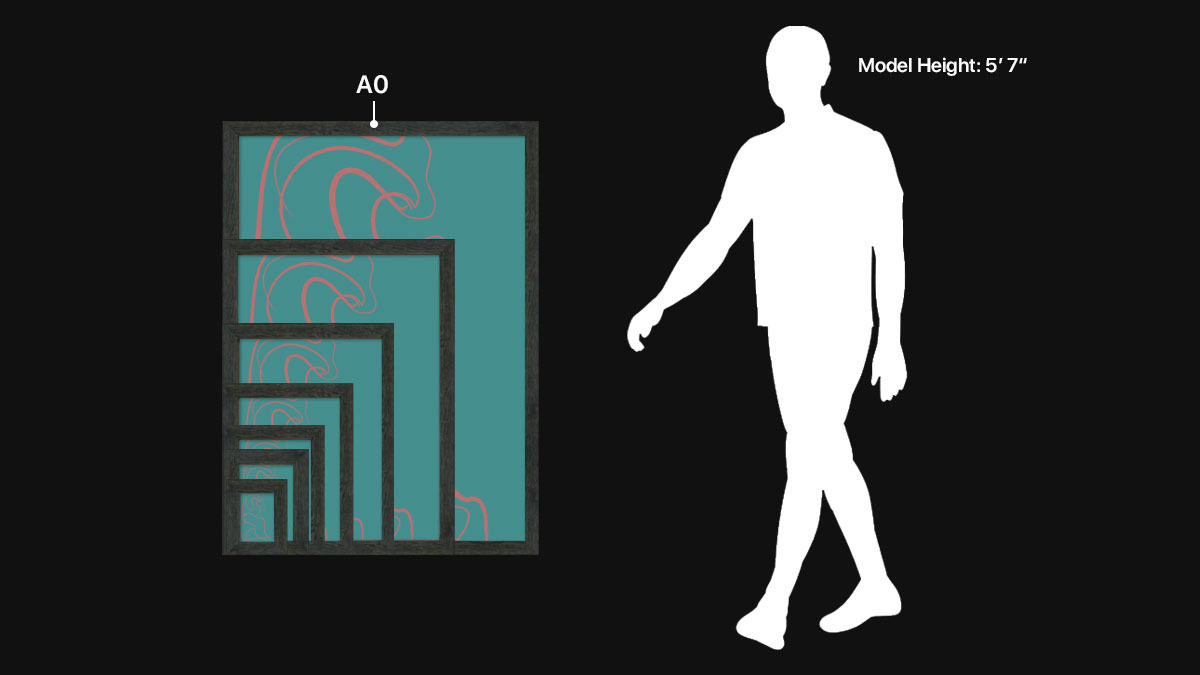
How do I measure A-Size artwork and frames?
To measure “A” paper sizes for framing, you will need a tape measure or ruler. Measure the width and height of the paper in millimetres and then use an “A” size chart or calculator to determine the size of the paper. For example, if the width of the paper is 841mm and the height is 1189mm, the size of the paper is A0.
Instead of relying on the artist, photographer, or print company’s word on the size of your picture, measuring it yourself to ensure accuracy is essential. Taking your own measurements will help you to determine the correct size for framing and guarantee that your finished product looks the way you want it to.
Our comprehensive measuring guide has more detailed instructions on how to measure every picture for framing. By following our instructions and double-checking your measurements, you can be confident that your frame will be the perfect size.
Here is a table with the A paper sizes and their dimensions in both centimetres and inches:
| Size | Dimensions (cm) | Dimensions (mm) | Dimensions (in) | Commonly Sold As |
|---|---|---|---|---|
| A0 | 84.1 x 118.9 | 841 x 1189 | 33.1 x 46.8 | 84 x 118cm |
| A1 | 59.4 x 84.1 | 594 x 841 | 23.4 x 33.1 | 60 x 84cm |
| A2 | 42 x 59.4 | 420 x 594 | 16.5 x 23.4 | 42 x 60cm |
| A3 | 29.7 x 42 | 297 x 420 | 11.7 x 16.5 | 30 x 42cm |
| A4 | 21 x 29.7 | 210 x 297 | 8.3 x 11.7 | 21 x 30cm |
| A5 | 15 x 21 | 148 x 210 | 5.9 x 8.3 | 6 x 8″ |
| A6 | 10.5 x 15 | 105 x 148 | 4.1 x 5.9 | 6 x 4″ |
| A7 | 7.5 x 10.5 | 74 x 105 | 2.9 x 4.1 | 7 x 10cm |
Some countries, such as the United States, have paper sizes that do not match the “A” series. If you are in one of these countries, you may need to use a different chart or calculator to determine the size of your paper.
The relationship between each size
Note that the A paper sizes are based on a 1:2 ratio, meaning that each size is half the size of the previous size.
Each size in the series is determined by halving the preceding size along its longer side. For example, A2 is half the size of A1, and A4 is half the size of A3. This means that the width-to-height ratio of all A series paper sizes is the same, regardless of the size of the sheet.
Viewing distances
The recommended viewing distance for a piece of art can depend on its size, the size of the room, and the viewer’s personal preferences. We talk about hanging your picture in more depth. However, here are some general guidelines for the recommended viewing distance of different-sized pieces of art:
- Small pieces (e.g. A7 to A4): At least 1m (40 inches)
- Medium-sized pieces (e.g. A3 to A2): At least 1.5m (60 inches)
- Large pieces (e.g. A1 to A0): At least 2m (80 inches)
Again, these are rough estimates, and you may want to adjust the viewing distance based on your specific circumstances. It’s important to consider the size of the room and the placement of the art to the viewer when determining the appropriate viewing distance.
What to consider when buying an “A” size frame?
Shopping for “A” size frames can be a great way to add a professional touch to your artwork, prints, and photographs. At our store, we offer a wide range of “A” size frames in all the standard sizes: A0, A1, A2, A3, A4, A5 and A6.
If you don’t have an “A” size frame and are looking to frame artwork that doesn’t quite fit one of the standard sizes, don’t worry! Our store offers custom framing options that allow you to get the perfect fit for your artwork.
With our custom framing service, you can choose your frame’s size, style, and material to suit your specific needs. Provide us with the dimensions of your artwork, and we will create a frame to fit it perfectly.
When choosing a frame for your item, like a certificate or poster, it is important to consider more than just the size:
- Style: Do you want a traditional or more modern look? Do you want a frame with a simple, clean-lined design or one with more ornate details? Consider the style of the frame and how it will fit with the decor of the room where it will be displayed. Our frame collections might be a good place to start if you’re searching for a frame by style.
- Material: “A” size frames are available in a variety of materials, including wood and metal. Each material has unique characteristics and can give the frame a different look and feel. For example, a wooden frame may add a warm, classic touch to your picture, while a metal frame may give it a more modern, sleek appearance. To help you, we have a great wood vs metal picture frame guide.
- Colour: Consider the colour of the frame and how it will complement your piece. A neutral-coloured frame, such as black, white, or natural wood, may work well with a variety of pictures and decor styles. Alternatively, choose a frame in a bold, eye-catching colour to make your art stand out.
Ultimately, the best frame for your picture will depend on your preferences and the look and feel you want. With so many options available, you are sure to find a frame that meets your needs and enhances the overall appearance.
Printing digital files
When it comes to printing digital images, the resolution is important to consider to ensure that the images print clearly and without blur. Resolution is typically measured in dots per inch (DPI), which refers to the number of pixels in an image per inch of printed space. The higher the resolution, the more pixels are packed into a given area, which results in a clearer and more detailed image.
As a general rule of thumb, digital images should have a resolution of at least 300 DPI to print clearly without blur. This is because most printers can print at a resolution of 300 DPI or higher, and using an image with a lower resolution can result in pixelation or blur.
However, it’s important to note that the actual DPI needed for a clear print may vary depending on the size of the print and the desired level of detail. For example, if you are printing a small image that does not require a lot of detail, you may get away with a lower DPI. On the other hand, if you are printing a large image or one with many fine details, you may need a higher DPI to maintain clarity.
To make it easy for customers planning to print A-size pictures, here are the dimensions and pixel counts for each of the “A” paper sizes at varying levels of quality.
| Paper Size | 150 DPI Bad |
200 DPI Okay |
250 DPI Good |
300 DPI Perfect |
|---|---|---|---|---|
| A0 | 1262 x 2523 | 1682 x 3354 | 2101 x 4195 | 2523 x 3677 |
| A1 | 891 x 1262 | 1187 x 1682 | 1461 x 2101 | 1783 x 2523 |
| A2 | 630 x 891 | 841 x 1187 | 1052 x 1461 | 1261 x 1783 |
| A3 | 445 x 630 | 594 x 841 | 732 x 1052 | 893 x 1261 |
| A4 | 315 x 445 | 420 x 594 | 525 x 732 | 630 x 893 |
| A5 | 222 x 315 | 296 x 420 | 371 x 525 | 444 x 630 |
| A6 | 157 x 222 | 210 x 296 | 263 x 371 | 315 x 444 |
| A7 | 111 x 157 | 148 x 210 | 185 x 263 | 222 x 315 |
Find any size frame online, including all the paper sizes
Buy frames for your walls and get delivery as quickly as tomorrow. Plus, they’re guaranteed to fit your picture perfectly.
Shop NowThe post The Ultimate Guide to Framing A-Paper Sizes appeared first on blog.
]]>The post The Art of Preservation: The Importance of UV Protection in Preserving Your Art appeared first on blog.
]]>The importance of UV protection in preserving artwork cannot be overstated. Artwork is often a significant financial and emotional investment, and preserving it can help protect that investment and ensure that it retains its value over time. UV protection is particularly important for valuable or sentimental artwork that you want to preserve its original condition for a long time and for artwork displayed in areas with strong UV light, such as near windows or in outdoor spaces.
Glass and acrylic
There are typically two types of UV glazing:
- Museum glass: For professional-grade UV protection, you might consider conservation or museum glass. Both options offer 97% protection but are usually too expensive and fragile for use in a family home. We offer these options to our trade customers only.
- Acrylic (Clarity+): More affordable than conservation or museum glass, and is also safer as it does not shatter. In addition, it provides a high level of UV protection at 99%. It’s our preferred choice almost every time. It comes as standard in all our custom frames and picture frames.
We have a handy glazing guide that tells you all about the advantages and disadvantages of both, helping you to choose the right material for your frame and picture.
UV light’s effect on artwork over time
The rate of fading depends on various factors such as the intensity of UV light, the type of artwork, and the materials used to create it. Artwork on paper and oil paintings may fade and change colour more easily than acrylic paintings or pigment-based prints.
So why should I choose UV-resistant glazing?
- Prolongs the lifespan of the artwork: By protecting the artwork from UV light damage, UV protective glazing can help extend the lifespan of the artwork. This can be particularly important for valuable or sentimental artwork that you want to preserve for a long time and pass down generations.
- Protects your investment: Artwork can be a significant financial and emotional investment. By using UV-protective glazing, you can help protect your investment and ensure that your artwork retains its value over time. Artwork that differs from its original condition will significantly decrease in value and aesthetic appeal.
- Maintains the integrity of the artwork: UV light can cause physical changes to the artwork itself, such as cracking or fading. By using UV protective glazing, you can help maintain the integrity of the artwork and ensure that it remains in its original condition.
- Enhances the appearance of the artwork: UV protective glazing can help preserve the colour and vibrancy of the artwork, which can enhance its overall appearance. This can be especially important for artwork that is displayed in a prominent location or is meant to be a focal point in the room.
Choosing the right glazing
There are several types of UV-protective glazing materials available, such as acrylic and glass, that can be used to protect artwork from UV light damage. When choosing UV protection for your artwork, there are several factors to consider:
- Type of artwork: The type of artwork you are framing will influence the type of UV protective glazing you choose. For example, if you are framing an original photograph or limited edition print, UV glazing is probably worth the investment. However, if the artwork is cheap or not valuable, the cost of UV-protective glazing may not be worth it. In this case, it may be more economical to replace the artwork if it becomes damaged rather than invest in high-end framing materials.
- Intended display location: The intended display location of the artwork will also influence the type of UV protective glazing you choose. For example, if the artwork will be displayed in a location with strong UV light, such as near a window or skylight, you may want to choose glazing with a higher level of UV blocking. On the other hand, if the artwork is displayed in a location with low levels of UV light, a less expensive glazing material that lacks UV protection will most likely be okay.
- Desired level of clarity: The level of clarity you desire for the glazing will also influence your choice. Acrylic glazing tends to be clearer than regular float glass, but unless you order an anti-reflective version, you may suffer from distracting reflections.
- Additional features and properties: In addition to UV blocking and reflection reduction, there are other features to look for when choosing a glazing material, such as abrasion and shatter resistance. These additional features can help protect people and the artwork from other types of damage and improve the overall viewing experience.
Need help choosing the right glazing? Get in touch and our expert frames can help you.
When not to choose UV glazing
While the use of UV glazing is generally recommended for preserving artwork, there are some artists and collectors who may prefer not to use any glazing. Some of the reasons for this include:
- Alteration of the artwork’s appearance: Some people may feel that the glare or reflection caused by glazing can distract from the artwork itself or that the added layer of glazing can affect the texture or overall look of the piece. While these concerns are understandable, it is important to consider the potential benefits of using UV protective measures and weigh them against any potential drawbacks.
- The artwork doesn’t warrant it: If the artwork is not particularly valuable or sentimental and is relatively cheap and easy to replace, you may decide that the added cost and effort of using UV glazing is not worth it. In this case, you may prefer to simply replace the artwork if it becomes damaged or faded over time.
- It’s not exposed to UV light: If the artwork is intended to be displayed in a location with very low levels of UV light, such as a room with no windows or minimal natural light, you may decide that the added protection of UV glazing is not necessary.
- There are other protections already in place: If the artwork is already protected by other means, such as being displayed behind UV-blocking window film or it’s got a UV-protective lacquer already applied, you may not require UV glazing.
More on UV-lacquers
Applying a UV-protective lacquer to the surface of artwork is another option for protecting it from fading and discolouration caused by UV light. This can be particularly useful for artwork that cannot be glazed or mounted, such as three-dimensional objects or artworks on paper that are delicate and could benefit from a protective coating.
UV-protective lacquers are applied as a thin layer over the surface of the artwork. Some lacquers are also water-resistant and can help to protect the artwork from moisture damage.
Things to consider with UV-lacquers:
- Compatibility with the artwork: It is important to make sure that the lacquer is compatible with the material of the artwork. Some lacquers may not work well with certain materials, such as delicate or porous surfaces, and may cause discolouration or other types of damage.
- Gloss level: UV-protective lacquers are available in different gloss levels, from matte to high gloss. It is important to choose a gloss level that is appropriate for the artwork and the intended display location. A high gloss lacquer may be more reflective and may cause glare, while a matte lacquer may be less reflective but may not provide as much protection from UV light.
- Drying time and handling: UV-protective lacquers typically have a longer drying time than other types of finishes. It is important to allow the lacquer sufficient time to dry before handling the artwork or displaying it. In addition, be sure to handle the artwork gently while the lacquer is drying to avoid disturbing the surface.
Oil paintings are particularly sensitive to UV light, making them a common medium that can benefit from the use of UV-protective lacquers. When applying a lacquer to an oil painting, it is essential to be careful not to apply too much, as this can alter the appearance and texture of the painting. To avoid any adverse effects, it is advisable to test the lacquer on a small area of the painting before applying it to the entire surface. By following these steps, you can ensure that the lacquer is applied correctly and effectively protects the painting from the damaging effects of UV radiation.
What about UV inks?
It’s important to consider the lightfast and UV resistance properties of inks when selecting them for a printing, as the longevity and quality of the finished product may be affected.
- UV inks are a type of lightfast ink that are resistant to fading when exposed to ultraviolet (UV) light. These inks are formulated to withstand the damaging effects of UV light and maintain their colour integrity over time. They are often used for printing applications where the printed materials will be exposed to UV light, such as outdoor signs, banners, and labels. It is uncommon to find fine art that’s been printed using UV inks
- Lightfast inks, on the other hand, are inks that are resistant to fading or discolouration when exposed to light. These are the inks we use when printing photos and artwork for customer uploaded images. They are commonly used in the printing of art reproductions, books, and other materials that will be displayed for long periods of time. Like UV inks, lightfast inks are formulated to maintain their colour integrity over time, but they are not specifically designed to withstand the effects of UV light.
There are inks that are not specifically formulated to be UV resistant, and therefore may be more susceptible the effects of UV light.
Caring for artwork protected with UV acrylic glazing
To help ensure that your artwork stays in good condition and retains its value over time, it is important to properly care for it, especially if it is protected with UV acrylic glazing. Here are some tips for caring for your artwork:
- Cleaning the glazing: To clean the UV acrylic or glass glazing, use a soft, lint-free cloth and a mild, non-abrasive cleaner. Avoid using any cleaners that contain alcohol or ammonia, as these can damage the glazing. Gently wipe the surface of the glazing in a circular motion, being careful not to scratch the surface. For hard-to-reach areas, such as the corners of the frame, use a soft-bristled brush to gently remove any dirt or debris.
- Handling the artwork: When handling the artwork, be sure to use clean hands and avoid touching the surface of the artwork as much as possible. If you must touch the artwork, be gentle and use a light touch. Avoid handling the artwork by the edges of the frame or the glazing, as this can cause damage. If you need to move the artwork, be sure to lift it carefully and use both hands to support the weight.
- Storing the artwork: When storing the artwork, be sure to choose a location that is dry, cool, and out of direct sunlight. Avoid keeping art in damp or humid conditions, as this can cause lasting damage in the form of mould. If possible, store the artwork horizontally rather than vertically, as this can help prevent the picture from creasing or going wavy. If you need to store the artwork for an extended period of time, consider using acid-free tissue paper or bubble wrap to help protect it.
Final words
Artwork is a valuable and often sentimental investment, so it’s important to protect it from the damaging effects of UV light. Using UV-protective glazing, such as acrylic or glass, can help preserve the quality and integrity of your artwork. When choosing UV-protective glazing, consider the type of material, location of the artwork, additional features, cost, and professional advice.
Top tips for finding the right UV-protective glazing for your artwork:
- If the artwork is not particularly valuable or sentimental, it might not be worth the cost to use UV protective glazing
- Research different types of materials, like acrylic and glass
- Consider the location of the artwork, especially if it will be in direct sunlight or a location with high levels of artificial UV light
- Look for additional features, such as anti-reflective coatings and abrasion resistance
- Consider the cost and choose a material that fits your budget
- Seek out professional advice from a picture framer or art conservator
Find a frame and customise your choice of glazing online
Buy frames for your walls and get delivery as quickly as tomorrow. Plus, they’re guaranteed to fit your picture perfectly.
Shop NowThe post The Art of Preservation: The Importance of UV Protection in Preserving Your Art appeared first on blog.
]]>The post Holiday Gift Guide appeared first on blog.
]]>Why give a frame as a gift?
While a picture frame may seem like an unusual choice for some, it’s actually one of the easiest ways to give a gift that both captures your recipient’s personality as well as your relationship with one another. By gifting a frame, you gift the opportunity for your loved one to hang and frame their favourite artwork while also providing a visual reminder of your friendship that’s now a part of their home.
Another reason why frames make such great gifts is their ability to transform a space; sometimes, a well-placed frame can make the difference between a stunning, eye-catching interior or, instead, an average unflattering one. This transformation ability comes at a much lower cost than other methods, such as painting walls or adding furniture, so by gifting your loved one a frame, you’re gifting a powerful interior design tool, especially if they have any particular interest in art, photography, travel etc.
Gifts for artists
What higher praise can there be for an artist than receiving a quality frame to showcase their work? If you have a loved one who enjoys creating artwork, whether it’s doodling or an oil painting, a picture frame that fits their medium size is the ideal present. It can help make their artworks look more professional, turning their hobby into a true craft, and show them your appreciation of their art. When looking for frames for artists, make sure to pick a frame in a size that will fit their work; for example, if they tend to draw on standard paper, you will want to ensure you get an A4 frame. Many companies like us even offer picture fitting, so for the ultimate surprise, you could send their art away to get fitted in their new frame before being delivered, ready to hang.
Gifts to remember trips and travel
The last few years have been particularly hard on those who love to travel, so if you know someone who has been desperately waiting to get back on the move, a frame is a perfect gift. With a range of different styles and techniques, multiple travel pictures can be displayed in a frame arrangement, perfect for reflecting on past expeditions while looking forward to the future.
Gallery wall displays are very popular with interior designers, as they allow for many pictures to be framed and hung together, creating a stunning display. This is often achieved through multiple smaller frames, which can all be the same style or an eclectic mix, and would give your loved one ample opportunity to display their most treasured moments. A multi-aperture frame provides the same versatility of holding more than one image at a time, but they are all contained within one frame, which lowers costs and also makes it easier to position and hang. Either way, you’ll be gifting a canvas waiting to be filled with happy memories; remember to make sure the frame accommodates standard sizes (e.g. 6×4″).
Gifts for kids
Children are notoriously difficult to buy for, thanks to their rapidly changing interests and the constantly changing world of technology and pop culture. While a picture frame may seem like an unusual choice, a large poster in a kids’ room is the perfect way to add a touch of personality while being easily changed whenever their interests change. Remove the previous poster and insert a new one to keep the frame relevant and appealing. While colourful frames are a great choice for a kids’ room, a lot of our black and white frames are also an excellent choice as not only do they look stunning, but they also are highly versatile. They will work with various colour schemes and artwork styles thanks to their neutral designs.
Contemporary gifts
If you’re looking for a frame that might suit your loved one’s trendy interior, we offer a wide range of frames that can suit any modern space. Picking a frame for someone else’s interior can be tricky, so take a look around their space and try to stick to what you see, look for the palette of colours they’ve chosen and the types of materials and textures they favour. For maximum versatility, we’d recommend sticking with a slim flat profile and a neutral tone, such as black, white, natural wood etc. These frames favour a minimalist style, which helps them blend into a variety of spaces as well as showcase a range of art styles beautifully.
Traditional gifts
For loved ones who have a home decorated with traditional adornments, why not gift an ornate traditional frame for the ultimate seasonal memento? We offer a wide variety of traditionally styled frames, so it shouldn’t be too difficult to find one that matches their interior. Just make sure to consider wood tones, metallic tones and styles. Some of our larger, more sturdy frames would work brilliantly as a large statement piece, while some of our more subtle designs would be better suited for smaller artworks.
Hopefully, our guide has given you a few Christmas gift ideas, but if you need more information about the frames and services we provide, or even advice on particular styles, get in touch with our customer service team. They will be more than happy to point you in the right direction.
The post Holiday Gift Guide appeared first on blog.
]]>The post Where and how to hang pictures appeared first on blog.
]]>Typically, people rush into designing their perfect frame but don’t consider whether the weight, size and proportions are suitable for the wall on which it will be hung.
Unfortunately, buying and hanging picture frames for your pictures has traditionally been laborious and expensive.
Thankfully, we fixed all this with our online framing tool (which allows you to customise your perfect made-to-measure frame, in wood or metal, in seconds).
Note: you don’t have to worry about being a framing expert. We designed our website to help you choose and customise the best frame for your picture in no time.
This guide will provide an overview of all the crucial factors to consider for choosing, placing and hanging your frames.
Framing your pictures with eFrame – here’s how it works:
We’ve made getting your art, photos, posters, and prints framed a doddle. Here’s how our process works:
- Find the best frame for your picture by browsing our range of picture frames or bespoke frames (you can also upload a digital photo for us to print and frame)
- Buy your new frame online without visiting your local framer, and escape the hidden extras they try to sell you. You can pay for your frames securely with your card or Apple Pay.
- We’ll then ship your frames in a few days for you to put your picture in and hang
Why does planning where to hang my frame before buying matter?
In the beginning, the cost of framing your pictures might be a worry. You’ve probably heard horror stories of people paying over the odds for frames from their local shops. However, framing doesn’t need to be expensive, so how much should you expect to pay?
Let’s face it; custom framing isn’t as cheap as buying an off-the-shelf frame from certain Swedish furniture chains, and it never will be.
But for a beautifully made, custom-size frame made in the U.K. by craftspeople, you’d be surprised at how affordable it is.
Framing costs can vary significantly, however, and it’s dependent on numerous factors, such as:
- The type of frame you choose, e.g. wood or metal
- The quality of frame you choose, e.g. budget vs premium
- How big the frame is
- How many frames you need
- Any extras you purchase, e.g. mounts, glass etc.
For illustration, a straightforward black wooden A4 frame will be less expensive than a premium custom-made frame in aluminium.
Why do some frames cost more?
Each frame is made to order using raw materials supplied from abroad; this requires more time, labour, and materials (the larger the frame gets).
For a more in-depth explanation of framing costs, along with pricing examples and averages, check out our picture framing costs guide and our money-saving tips guide.
Considering where you want to hang your frame before ordering could save you money and post-purchase regret. Not doing so could mean you’re left with a frame that doesn’t fit the space, either physically or aesthetically.
Choosing the right picture frame for your space
The right frame for your space should complement your room, furniture and artwork. It’s all about balance, and by relying on your instinct to tell you what looks and feels right, you can create a harmonious way to show off your artwork.
Choose frames and artwork based on room and wall proportions
Utilising the proportions of your room will help your artwork integrate seamlessly. The first step is to assess your room and its furniture to give you an idea of the kind of frame(s) and sizes that might suit your space.
If your room is fairly minimal, follow that through with a single frame or diptych. If you have a “positive” space (one that’s filled with objects, materials and ‘things’), try hanging lots of frames together to keep it cohesive.
Pictures for spacious rooms
Large rooms and empty wall space call for large frames. They can help spaces feel more homely and add personality. Either go for one big statement piece frame or create a gallery wall. If you want to fill up space in a room with high ceilings, try hanging your pictures in portrait rather than landscape.
We have an amazing guide to help you buy big and oversize picture frames, here.
Pictures for smaller rooms
Don’t attempt to squeeze too many frames into a small space. One or two small framed pictures will bring character to a reading nook or small study without becoming overwhelming. Multi-photo frames and mounts can be a great way to frame a collection of photos in a small space without crowding your walls.
Match your artwork mood to your home
Frame style is largely irrelevant in terms of hanging advice. However, we do have online advice for choosing the right frame style and also decicing between wood and aluminium.
Shop wall hanging frames for your pictures online
Buy frames for your walls and get delivery as quick as tomorrow. Plus they’re guaranteed to fit your picture perfectly.
Shop NowWhere do you want to hang your art?
Most people know where they plan to hang their framed piece before ordering.
Typically, you’ll fall into one of two camps:
- Hanging a frame on a blank wall
- Re-framing or replacing art that’s already hung up in the same or similar place
Hanging a frame on a blank wall
It’s not uncommon for people to want to hang frames in a new or different location. However, this will typically take more time than simply keeping your frames in the same location and reusing the existing wall fixings.
Re-framing or replacing art that’s already hung up in the same place
If you’re looking to refresh a wall where a framed piece is already hanging, the process will likely be more straightforward than placing something in a brand-new location. Swapping out a frame and hanging the new one in the same spot is quite simply a matter of taking the old one off and putting the new one on. Although you must ensure that the wall fixings can take the weight of your new framed piece.
Other things to consider when choosing a location
When choosing where to hang your frame, there are several other factors to consider:
- Safety: An important consideration is safety. For more on choosing a suitable location based on the glazing choice, click here.
- Lighting: The lighting in the room should also be considered when choosing where to hang your frame. If the frame will be displayed in a location with strong natural light, such as near a window, it may be more suitable to use UV protective glazing to protect the artwork from fading or discoloration. On the other hand, if the frame will be displayed in a location with low levels of light, it may be more suitable to use a glazing material with a higher level of clarity to allow for maximum visibility of the artwork. For more on choosing a glazing appropriate for art in areas of high sun or UV light, click here.
What size and shape of framed art should I buy?
The size of your frame is largely dictated by the size of your art.
That said, you can make the overall frame size substantially larger than your art by selecting a mount.
A mount is the card insert, sometimes referred to as a mat, that sits around your picture but within the wooden or metal frame. By increasing the size of your mount borders, you can create an overall larger frame, which is often useful for filling big, blank walls.
You can even change the overall shape of your frame using uneven mount borders.
You can adjust the mount borders to create frames of different sizes in our online studio, here.
By using a mount them, you can create almost any size and shape frame, irrespective of your art’s size and aspect ratio. Armed with this, you can now look at what size and shape frame might suit your room best. Here are five essential rules for designing a frame that will look great on any wall.
- Repeat shapes to create a display that’s pleasing to the eye. Repeating shapes will unite separate pieces of furniture and create a cohesive look and feel. For example, if you have a rectangular rug on your floor, echo that shape with landscape or portrait framed art rather than square.
- Rooms with particularly tall walls and high ceilings call for bigger frames, ensuring there isn’t too much white space between your artwork and the ceiling. For multiple picture frames, try spreading them across your wall with the lowest image at eye level, drawing attention across your space.
- Make sure there’s room for negative space. What’s negative space? It’s a design principle used to keep your room from looking cluttered. Incorporating negative space will help draw the eye into your framed piece too. The golden ratio suggests filling about 60 percent of your wall space with framed art, leaving 40 percent of the wall around your frame. This ratio of 1.618 will leave your display looking complete but not overbearing.
- Ensure that the scale of your framed piece is sized relative to the furniture in your room. For example, if you hang your frame above a console table or headboard, ensure that the frame doesn’t protrude beyond the ends. A general rule of thumb is to size framed artwork no bigger than half to two-thirds the width of the furniture below it. For example, a 210cm sideboard would pair well with a 140cm frame.
How high should I hang my frame
Once you’ve established what size, shape and style your frame(s) should ideally be, you’ll need to look more closely at exactly how high to hang them.
Single frames on an empty wall
If you’re hanging your frame on a blank wall, that is to say, there is no furniture underneath; you should hang your frames at eye level. This will make your art the focal point and look balanced on your wall. Obviously, depending on the height of your ceiling, you may want to move the frames up and down slightly, but generally speaking, the vertical centre of your framed art should hang between 57″ (144cm) and 60″ (152cm) from the floor. If the art is hanging in a kid’s room, you could lower the positioning slightly for their enjoyment.
Single frames above furniture
If you’re hanging a single piece of framed art above furniture, then the frame should be positioned between 4″ (17cm) to 12″ (25cm) above the furniture.
How high should I hang a gallery wall?
Finding the right height to hang a series of frames or a gallery wall is a more involved process, but there are some simple rules to make it easier.
Gallery walls on an empty wall
Our best advice is to treat the arrangement of frames like one entity and position the centre at roughly eye level. Much like above (for single frames), the vertical centre of your gallery wall should hang between 57″ (144cm) and 60″ (152cm) from the floor.
If you’re going for a more “organic” look and your gallery wall might evolve, pick a centre spot and build out.
Gallery walls above furniture
Galleries walls hung over a piece of furniture, like a sofa, should hang with a gap between 7″ (17cm) and 10″ (25cm) between the lowest frame and the furniture.
Other things to consider when deciding how high to hang your art
There is no “one height fits all” rule, so unconventional hanging spots might benefit from a slight deviation from our recommendations above.
If you’re hanging several artworks up a staircase, ensure the frames are all hung at eye level parallel to the staircase. Measure an eye-level height every few steps to create a diagonal line showing where to place your frames.
For spaces where individuals will most likely be sitting (e.g. dining rooms, offices and living rooms), you might want to hang your pictures slightly lower to bring them into focus more of the time.
How to hang your new frame
Okay, you’ve found a spot for your artwork and the perfect frame to showcase it; it’s time to hang your picture. The process might seem daunting if you don’t have much experience, but we’ll break it down and make it as simple as possible. Remember, you can always ask a friend or family member to help!
Which frame hardware should I use (the fixings physically attached to your frame)?
Most picture frames and photo frames are supplied with hanging fixings, either preattached or supplied loose.
For example, our own wall hanging picture frames are supplied with zinc-coated press fix hardware or D rings and polycord. We alternate between the two depending on a few factors, such as weight, size and depth.
Other framing companies or high street stores might supply frames with something different, such as:
- Sawtooth hangers
- Clip over hangers
- Security fixings
- Mirror plates
- Command strips
Upon request, we can supply the above.
You can read all about attaching your hanging fixings in our separate how-to guide, here
Should I use nails, screws or hooks to hang my frame?
Reliable and sturdy picture hangers are needed to hang your frame safely. The right hanger will be suitable for both the frame’s weight and the wall type (plaster, brick, etc.).
We’ll start with identifying your wall type. The simplest way to determine whether you have a plaster or brick wall is to tap it with your knuckles. A plasterboard, studded, or cavity wall will produce a hollow sound. Solid brick, block or dot-and-dab walls will sound solid.
Stud walls aren’t as sturdy as their solid counterparts. As such, extra care must be taken to ensure the right fixing is chosen. The options you have are:
- Spring toggle fixings
- Hollow wall achor
- Self drive plug
- Picture hooks
Each of the above should be strong enough to take up to 20kg in weight, more than enough to hang big frames, but check the weight rating label before buying.
Rawl-type plugs are your best choice for hanging frames on solid brick walls. You shouldn’t have any issues with hanging heavy frames on brick walls, but again, it pays to check the weight limit of the fixing type you decide on.
You’ll need to be wary of water pipes, electrical wiring and stud work. We advise using a detector before choosing the location you want to hang. For these reasons, there’s a risk that hanging your frames in a new location can be more complex and might require more time and effort than a standard, simple swap.
Heavy frames require heavy-duty fittings and fixtures. They can also benefit from 2 or more wall fixtures for added safety.
Picture hooks for your walls
Picture frame hooks are the most common way to hang a picture on a wall and have proved a popular method. The benefit of this technique is the simplicity and cost-effectiveness; all you need is a hook, hammer and nail; however, the disadvantage of this method is that it is not appropriate for all wall types (especially not plaster) and will need to be hammered into a stud for heavier artwork.
Other wall fixings
Plate fixings are slightly more secure than picture hooks, as the frame is essentially attached to the wall rather than hanging on an attachment point. This means you don’t have to worry about the frame getting bumped into and knocked off; however, this method requires screws attaching the plate to the frame and wall, meaning you will leave a larger hole than the frame hooks. Screws also may require anchors, depending on the wall type.
Hanging your picture
To work out where to put your nails, hold your frame to the wall around where you think it should be. Gently mark the top two corners of the frame on the wall with a pencil or masking tape, then mark the centre of these two points.
Take your frame and pull up the hanging cord to make it taut. Measure the distance between the centre of the cord or wire and the top of the frame. This measurement tells you how far down from the marking on the wall you should place your wall hangers and mark the spot. Doing it this way, when you hang your frame, the artwork will be in the desired spot.
Putting the nails in the wall
Gently hammer or screw your picture frame fixings into the wall after you have marked the location of your wall fixings.
If your frame is particularly wide or heavy, you might want to hammer in two fixings spread evenly about 2 to 3″ apart from the centre.
If you don’t want to leave holes in your wall, command strips and other non-permanent fixtures can be a useful alternative. It’s worth noting that it’s safest to use these fixtures with a lighter frame, and it’s possible to still damage the wall by peeling the top surface off if the removal instructions are not followed.
Use a spirit level once the frame has been hung to find its true level.
Leaning: An alternative to hanging frames
Some spaces may not suit frames hanging from the walls, but that doesn’t mean you can’t surround yourself with pictures you love. Larger frames look great leant against walls, while smaller frames can be a perfect homely touch tucked away on a bookshelf or desk or even supported on an easel or a picture rail.
Your favourite picture doesn’t have to be in a frame arrangement you’ve seen online. Your perfect frame should be positioned wherever works for you.
The post Where and how to hang pictures appeared first on blog.
]]>


